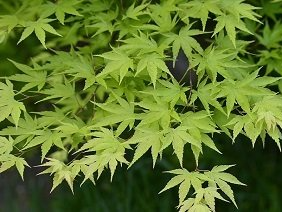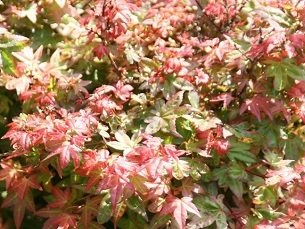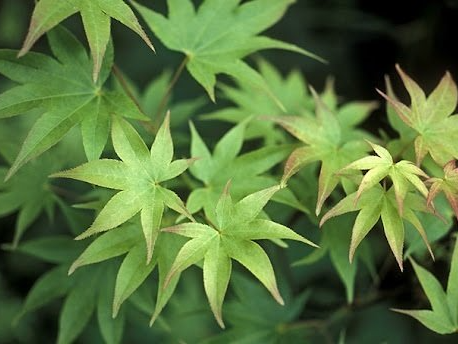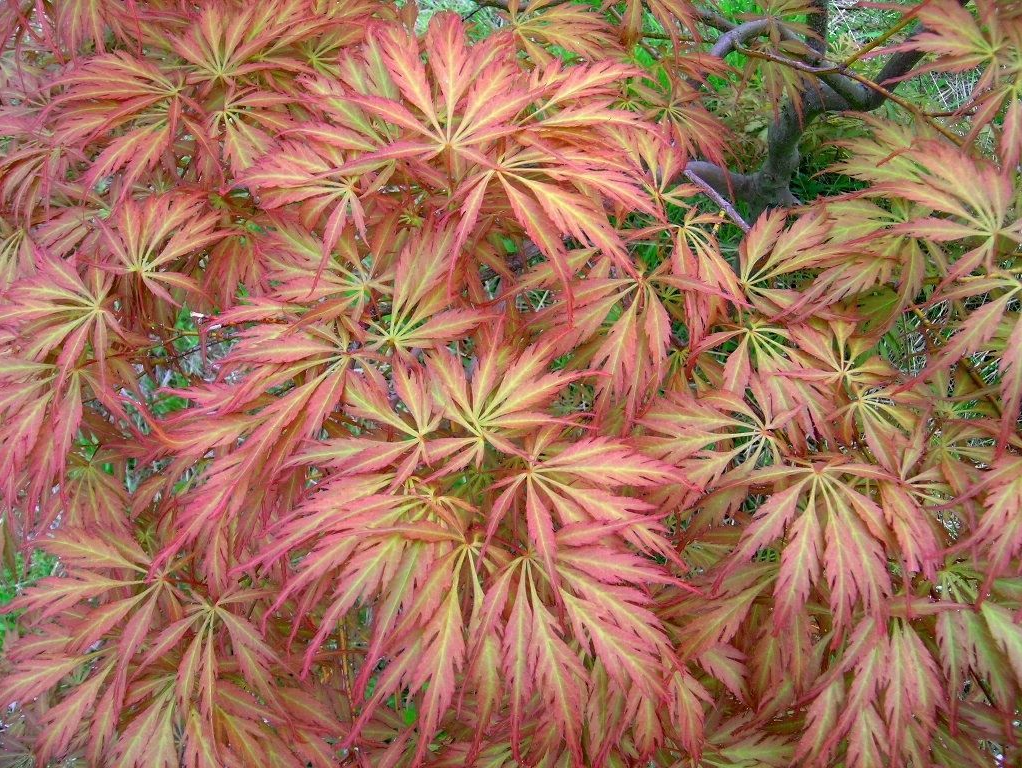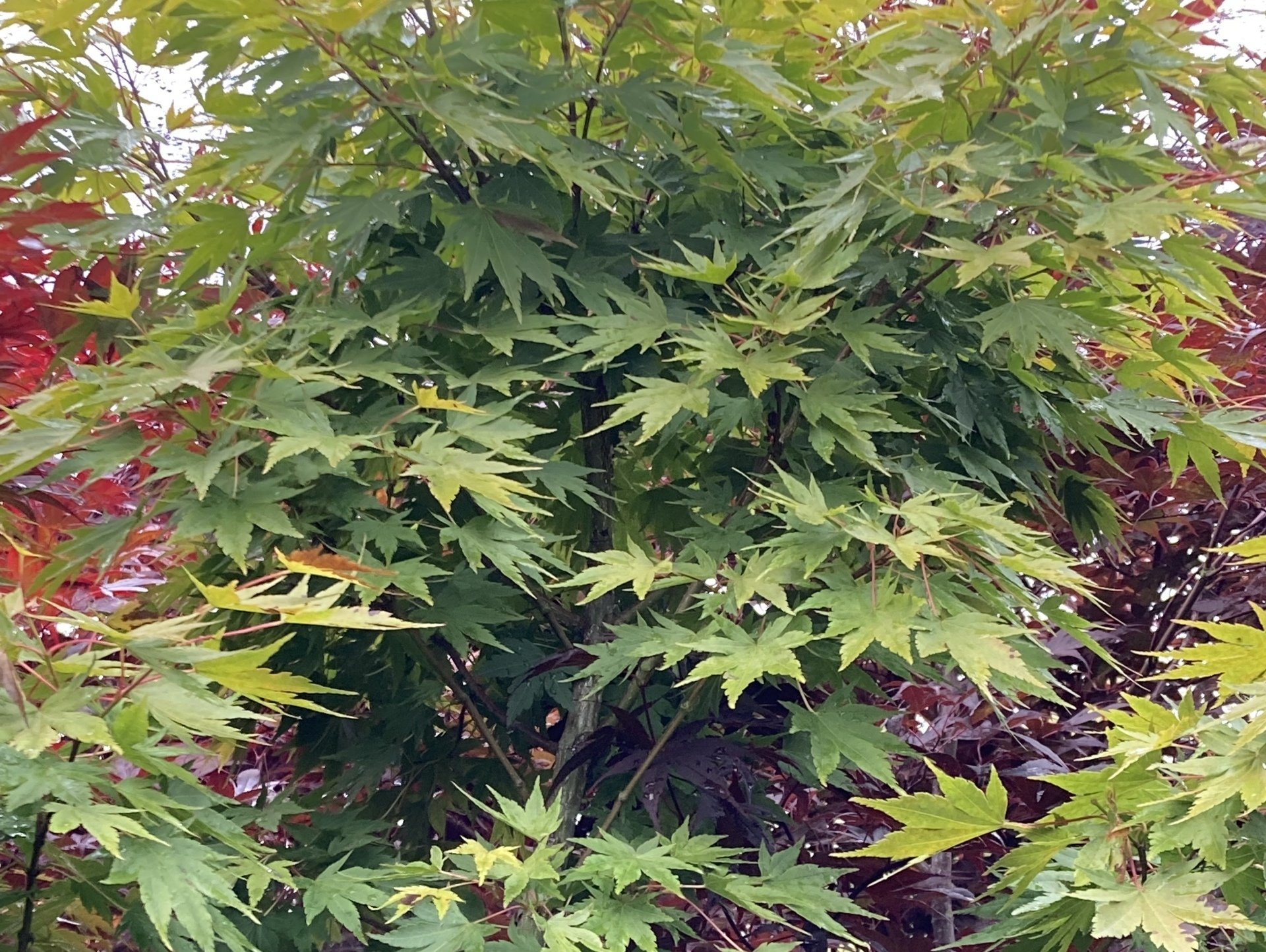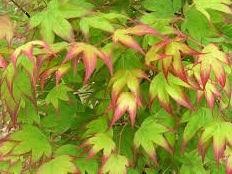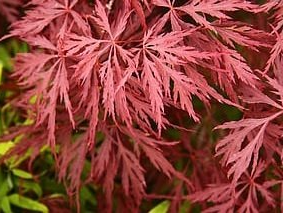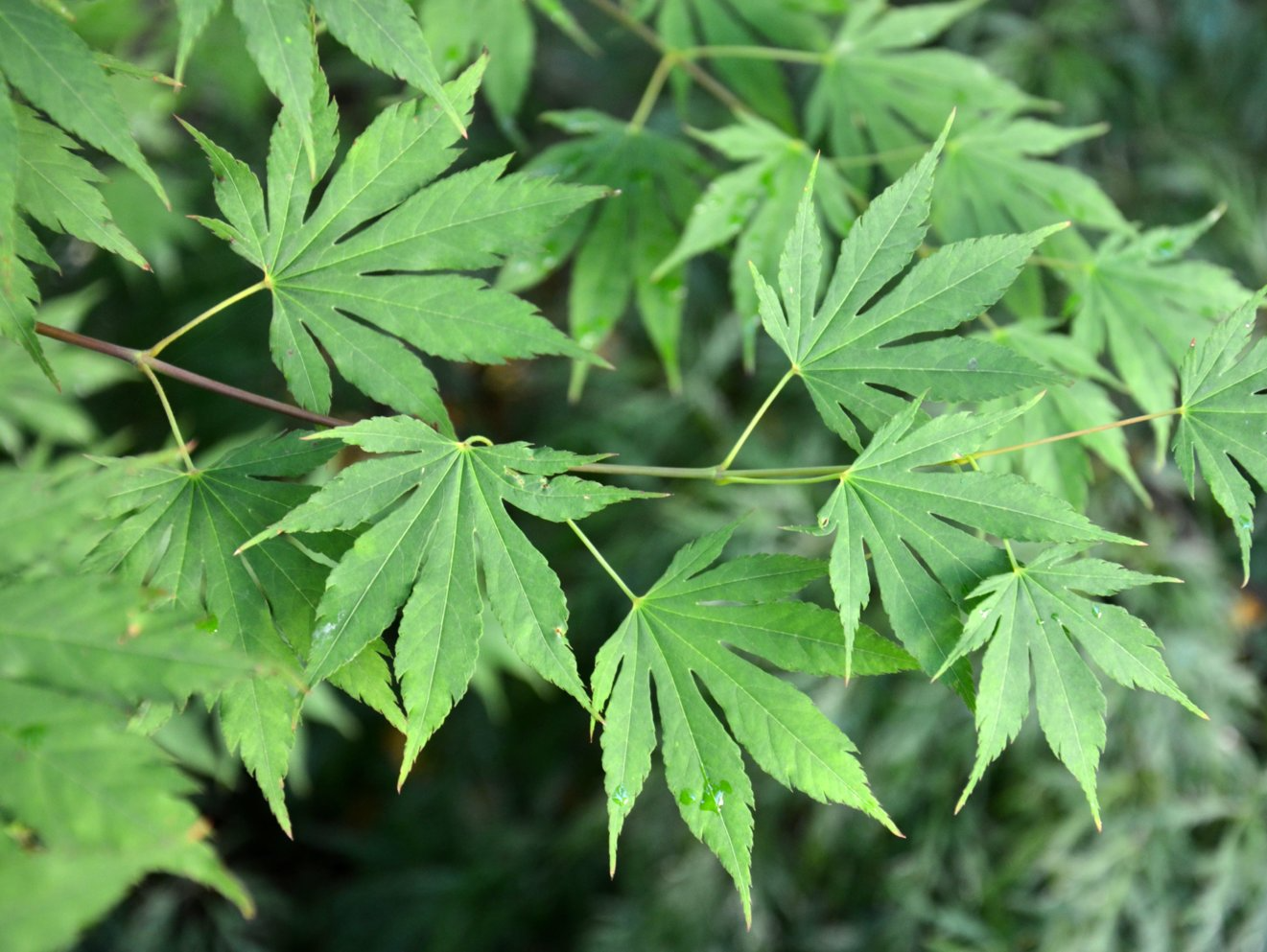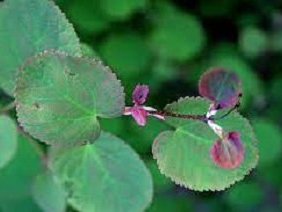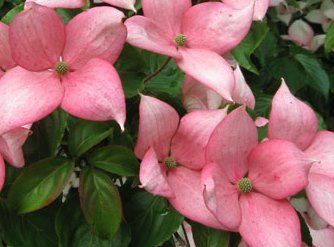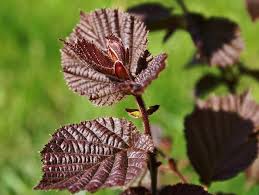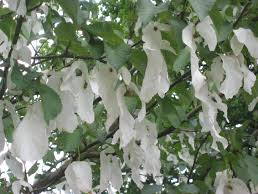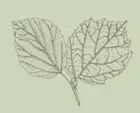TREES
Evergreen trees hold on to their leaves and stay "green" throughout the year. They do shed their old leaves to grow new leaves, but they drop them gradually, not all at once. This also includes most, but not all, varieties of conifers. For more information on conifers and our conifer collection, lease visit our Conifer page.
Deciduous trees will lose their leaves during the colder winter months and grow new leaves in the spring. They often put on a vibrant autumn show as their leaves change colors before falling to the ground.
This list represents plants that we commonly carry at the nursery. Please stop by the nursery or call us for current availability, (360) 862-1323. Thank you!
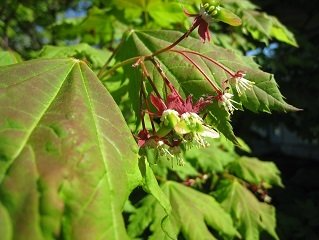
Acer circinatum
Vine Maple
Vine Maple
– A multi-stemmed, deciduous, large shrub or small tree. In sun, its branches are more upright; in the forest, they sprawl along the ground, giving it the common name of vine maple. They grow in a wide range of soil types and are drought tolerant once established. It grows more quickly (12 to 18 inches a year) when young. It matures at about 15 to 20 feet high and wide. Vine maples grow in full sun or part shade, however, fall color is best with at least half a day of sun. Hardy in USDA zones 5-8.
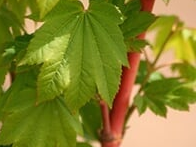
Acer circinatum
'Pacific Fire'
Pacific Fire Vine Maple
– A multi-stemmed, deciduous, large shrub or small tree. Flaming red bark in the winter dazzles the landscape with color. In summer fiery branches peek through large bright green leaves. In fall brilliant yellow leaves create an intense contrast. They grow in a wide range of soil types and are drought tolerant once established. Water regularly in summer. Grows to 10 feet tall in 8 years reaching 12-15 feet tall and wide. Part. Sun. Hardy in USDA zones 4-8.

Acer circinatum
'Pacific Purple'
Pacific Purple Vine Maple – A multi-stemmed deciduous, large shrub or small tree. They grow in a wide range of soil types and are drought tolerant once established. It grows quickly (12 to 18 inches a year) when young. It matures at about 15 to 18 feet high and wide. Vine maples grow in full sun or part shade but fall color is best with at least half a day of sun. Hardy in USDA zones 4-8.

Acer x freemanii
'Autumn Blaze'
Autumn Blaze Red Maple
– Hybrid of red maple (A. rubrum) and silver maple (A. saccharinum). This is an upright, fast-growing, deciduous tree with ascending branching and a dense, broad oval crown. Each medium green leaf is deeply cut with five pointed lobes. As the trade name suggests, the foliage turns into an autumn blaze of orange-red to scarlet-red fall color. It is easily grown in average, medium to wet, well-drained soil. Established trees have some tolerance for drought conditions. Fast grower approximately 3 feet per year maturing at 40-50 feet tall and 40 feet wide. Full Sun to Part Shade. Hardy in USDA zones 3-8.
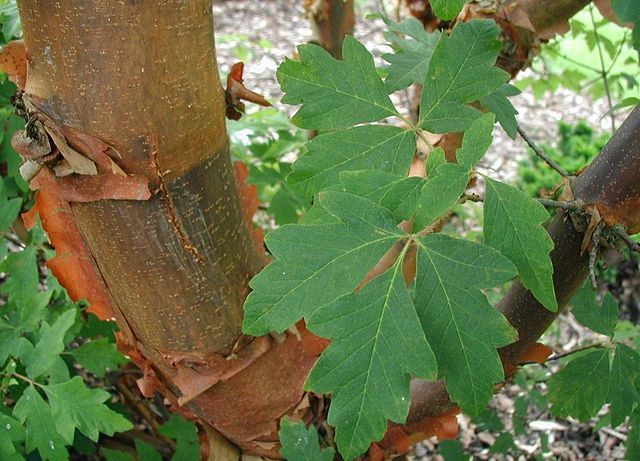
Acer griseum
Paperbark Maple
– Young trees have an upright branching pattern that widens with age. It thrives in fertile, humus-rich, well-drained soil. Paperbark Maples reach 10 to 18 feet tall and 8 to 15 feet wide in 10 years. Its ultimate height is 40 feet with a 30-foot spread. Plant Paperbark Maples in Full Sun or Part Shade. Hardy in USDA zones 5-8.

Acer japonicum
'Acontifolium'
Fernleaf Full Moon Maple
– A bold and beautiful tree. Deeply dissected leaves create a rich texture in the landscape. In early spring the bright green new leaves and small red flowers are subtle yet lovely. In autumn, the bright green leaves of this handsome tree explode into color, showing off shades of red and orange-tinged with purple and yellow. Full Sun to Light Shade. Hardy in USDA zones 6-8.
Acer japonicum
‘Green Cascade’
Green Cascade Full Moon Maple
– This small mounding tree has a weeping habit. Bears Finely-cut green leaves that turn brilliant yellow, orange, and red fall colors. Grows 10’ tall x 15’ wide. Partial sun to partial shade. Hardy in USDA zones 5-7.
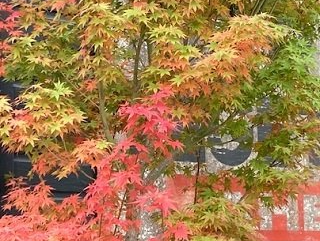
Acer palmatum
Japanese maple
– A versatile tree, any garden would benefit from. Sensational fall color, rich yellows, and reds, as late as November. The winter silhouette is also attractive. Prefers well-drained soil. Grows 15-25 feet tall and wide. Sun to Light Shade. Hardy in USDA zones 5-9.
Acer palmatum
‘Aoyagi’
Aoyagi Japanese Maple
– This graceful maple has an upright branching habit, light green foliage in spring turning a bright gold in fall. 10’ tall x 10’ wide. Partial to full sun. Hardy in USDA zones 5-8.
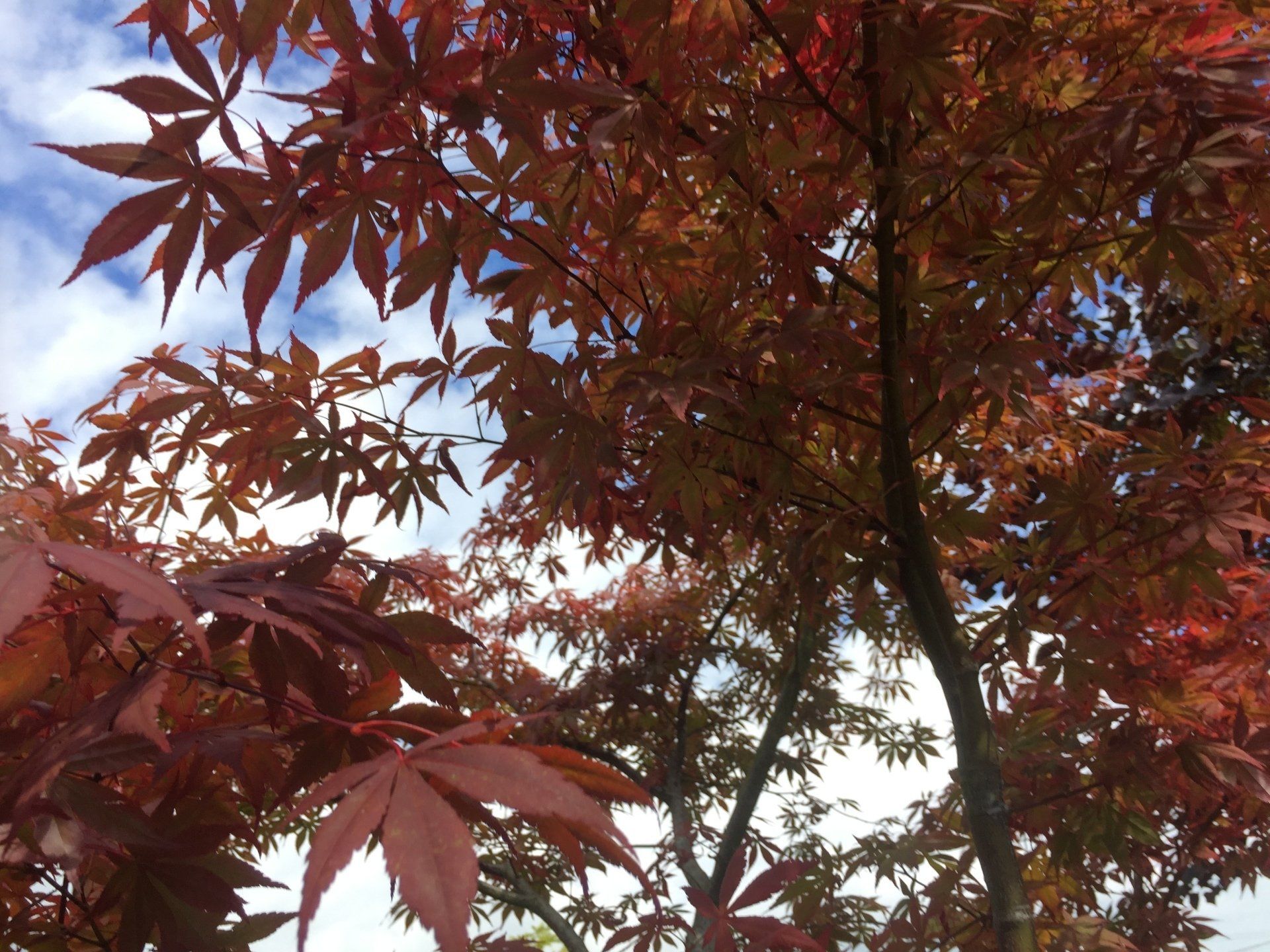
Acer palmatum
'Atropurpureum'
Red Japanese Maple
– Rich purple-colored leaves in spring to nearly black-red early in the season, but the color may fade in summer, even becoming green, brilliant scarlet in fall. Pendulous form, some even prostrate and must be staked initially, cascading branches become twiggy and dense with age. Slow growing to 10-15 feet tall over 10 years, maturing at 20 feet tall. Filtered Sun. Hardy in USDA zones 5-9.
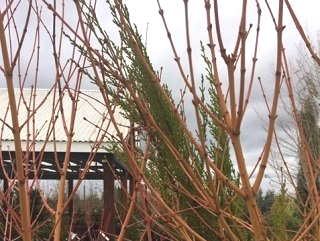
Acer palmatum
‘Bihou’
Bihou Japanese Maple
– Chartreuse leaves emerge in spring turn a medium green with a final show of warm golden orange. The striking honey tangerine bark offers year-round interest on this unique cultivar. 10’ tall x 8’ wide. Hardy in USDA zones 6-9.

Acer palmatum
'Bloodgood'
Bloodgood Japanese Maple
– Leaves have typical Acer palmatum
leaf shape with deep red leaves that mature to a rich purple in the early spring deep reddish-purple leaf color hold well into summer but may "bronze out" before turning crimson in the fall. Vigorous upright deciduous tree, maturing at 15-20 feet tall. Sun to Part Shade. Hardy in USDA zones 5-9.
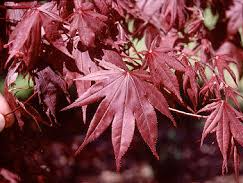
Acer palmatum
'Emporer 1'
Emporer 1 Japanese Maple
– Japanese maples are surprisingly flexible in their soil requirements. Although they grow best in humus-rich, well-drained, fertile soil, they grow well in most soils as long as they are not poorly drained or are heavy clay. Water regularly for its first two growing seasons and during subsequent summer dry spells. Careful pruning will enhance the graceful branching of this tree. Its foliage color is best in full sun but holds its fall color well in partial shade. Reaches 18 to 20 feet tall in ten years, ultimately reaching about 25 to 30 feet tall and wide. Hardy in USDA zones 6-9.
Acer palmatum
‘Japanese Sunrise’
Japanese Sunrise Japanese Maple
– This striking tree is in the coral bark maple group, offering striking reddish to melon-colored bark, spring green foliage matures a medium green followed by rich fall golden hues. Prefers partial sun to light shade. Matures at 16’ tall x 10’ wide. Hardy in USDA zones 6-9.
Acer palmatum
‘Kamagata’
Kamagata Japanese Maple
– This dwarf cultivar has a rounded habit and bears small bright green leaves that emerge with a tinge of red on the margins. Fall color is yellow turning orange-red. Prefers partial sun to partial shade. Matures at 3-4’ tall and wide. Hardy in USDA zones 5-9.

Acer palmatum
'Katsura'
Katsura Japanese Maple
– Fantastic pale orange-yellow spring foliage gradually fades to medium green in early summer. The soft oranges and yellows return during the fall leaf drop. This is an excellent tree for small gardens or large patio containers. Full Sun to Light Shade. Hardy in USDA zones 6-8.
Acer palmatum
‘Koto-no-lto’
Harp String Japanese Maple
– This maple has narrow, deeply divided leaf lobes and a dense, twiggy branch structure. The unique, divided green leaves have a tinge of red in spring and change to gold in autumn. Prefers morning sun and afternoon partial sun/shade. Matures at 6’ tall x 4’ wide. Hardy to USDA zone 5.
Acer palmatum
‘Mikawa yatsubusa’
Mikawa yatsubusa Japanese Maple
– This unique dwarf maple bears its bright green leaves close to the stems. Fall color is orange to red. Maturing at 6’ tall x 4’ wide in 10 years. Prefers partial sun to partial shade. Hardy in USDA zones 6-8.

Acer palmatum
'Orange Dream'
Orange Dream Japanese Maple
– A creamy sherbet orange in the spring lasting for several weeks, by far one of the best new trees and the best orange spring color. Orange Dream emerges later in the spring making it more suitable for colder climates. A small upright tree, adding beauty to any garden, suited to all applications. 10 feet tall in 10-15 years. Full Sun/Partial Shade. Hardy to USDA zone 6.
Acer palmatum
‘Orange Flame’
Orange Flame Japanese Maple
– This thread leaf Japanese maple has a mound shape. The foliage emerges light green and ages to medium green. The fall color is a deep orange to red color. Matures at 5-10’ tall x 6’ wide. Prefers full sun to partial shade. Hardy in USDA zones 6-9.
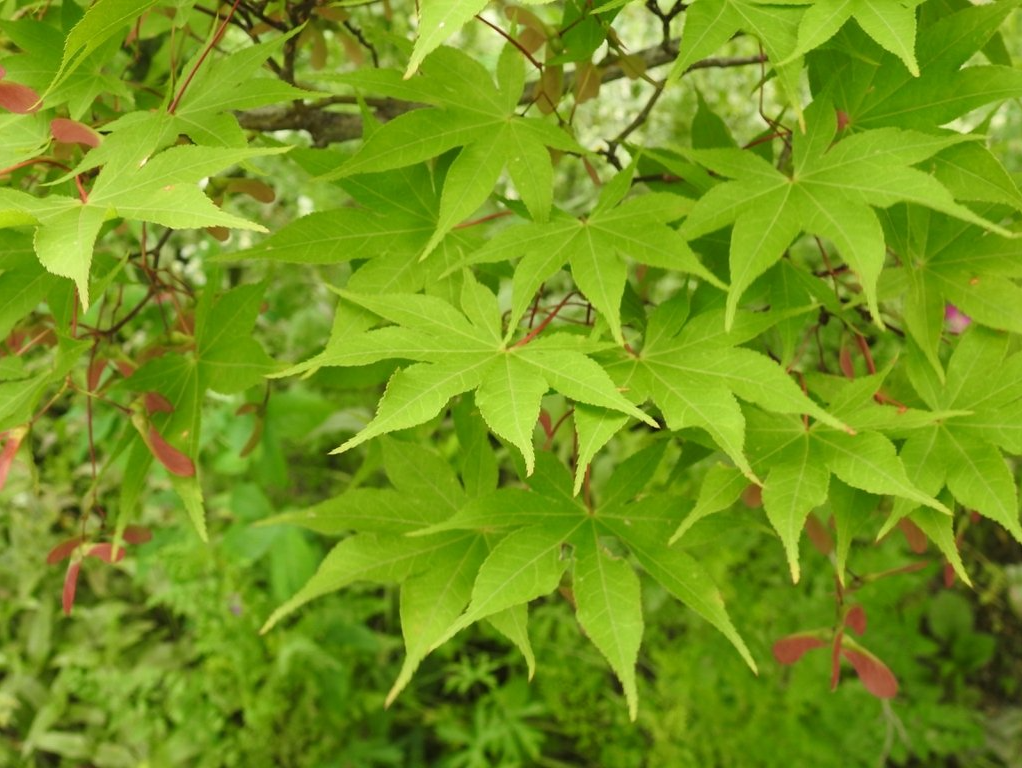
Acer palmatum
'Osakazuki'
Osakazuki Maple
– A famous cultivar, best known for its fall color. Foliage is a beautiful, rich green color in spring. A brilliant fall display of intense, glowing crimson. This tree has average water needs. Grows 15" to 18" inches a year in youth, slowing two to four inches of growth per year. Mature height 15-18 feet tall. Sun to Light Shade. Hardy in USDA zones 6-8.
Acer palmatum
‘Osakazuki akame’
Osakazuki akame Japanese Maple
– Broader growing than the standard ‘Osakazuki’, this variety shares the same sturdy stature and amazing fall color of the standard. Leaves are olive-orange in spring and change to green as they mature. Reaches a height of 20’ tall x 15’ wide. Prefers full sun to partial shade. Hardy in USDA zones 5-9.

Acer palmatum
‘Pixie’
Pixie Japanese Maple
– This dwarf variety has rich burgundy foliage. Fall color becomes reddish. Reaches 4’ tall x 3’ wide in 10 years. Matures at 8-10’ tall x 6’ wide. Prefers full to partial sun. Hardy in USDA zones 5-9.
Acer palmatum
‘Rhode Island Red’
Rhode Island Red Japanese Maple
– This dwarf variety has deep burgundy foliage and a mounding habit. Matures at 6’ tall x 6’ wide. Prefers full to partial sun. Hardy in USDA zones 5-9.
Acer palmatum
‘Roseo-marginatum’
Roseo-marginatum Japanese Maple
– Delicate variegated foliage is offered on this vase-shaped small tree. Matures at 8-10’ tall x 6’ wide. Prefers partial sun to partial shade. Hardy in USDA zones 6-9.
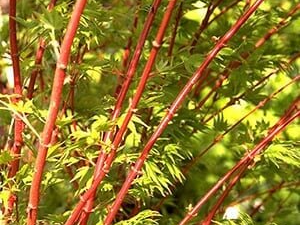
Acer palmatum
'Sango Kaku'
Coral Bark Maple
– The brilliant coral colored bark is outstanding. Foliage in spring-summer is bright green, changing to vivid yellow in the fall. Equally beautiful throughout the year. A true four season tree. Grows to 20-25 feet tall and 15-20 feet wide. Full Sun. Hardy in USDA zones 5-8.
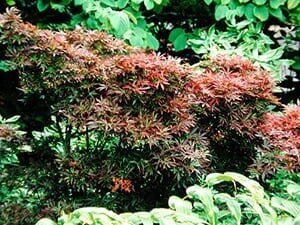
Acer palmatum
'Shaina'
Shaina Japanese Maple
– A true dwarf, ‘Shaina’ becomes a low dense and compact globe of small red foliage. In spring the leaves emerge a bright red deepening to dark maroon in summer. The foliage forms dense tufts at the ends of short twiggy branches and can develop an interesting and intricate form with some pruning. The maroon leaves turn a brilliant crimson in the fall. This is an ideal selection for containers or as a colorful accent in a small garden. Reaches 4 feet tall by 3 feet wide. Light to open Shade. Hardy in USDA zones 6-9.
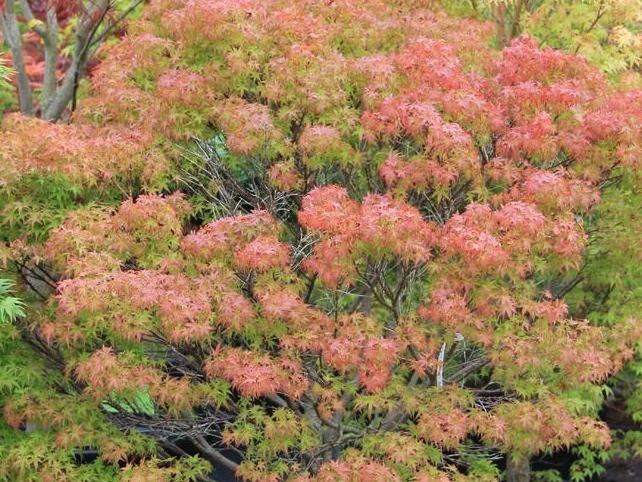
Acer palmatum
‘Sharp’s Pygmy’
Sharp’s Pygmy Japanese Maple- This dense, rounded shrub is covered with small, green palmate leaves from spring through summer turning a striking red in fall. Matures at 4’ tall x 4’ wide. Prefers morning sun and afternoon partial sun/shade. Hardy to USDA zone 5.
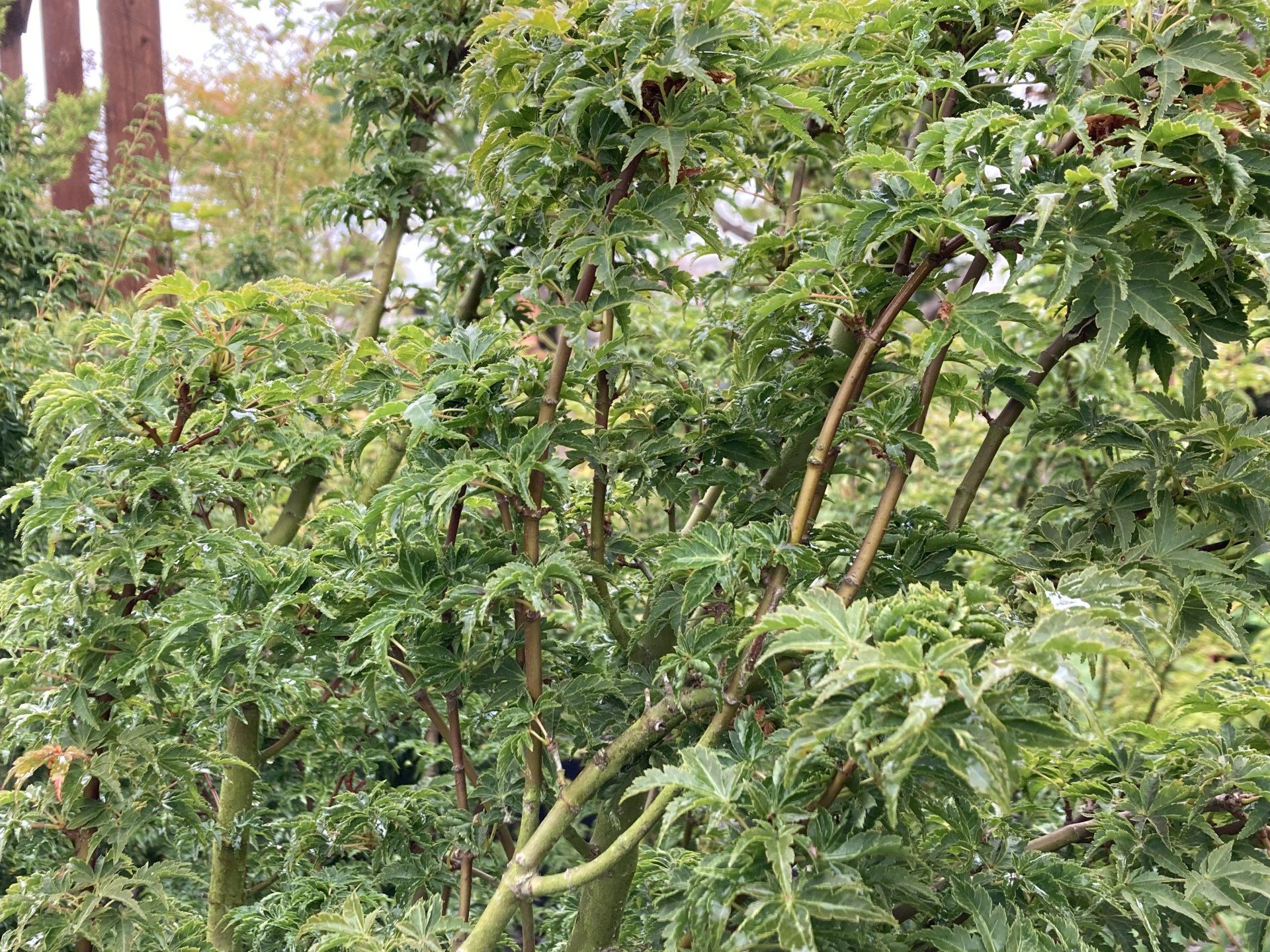
Acer palmatum
‘Shishigashira’
Shishigashira Japanese Maple
– This unique upright tree has a compact habit. The foliage has a crinkled form and emerges close to the stems. Bears soft to medium green foliage that matures to golden reddish shades in fall. Matures at 7’ tall x 5’ wide. Prefers full sun to partial shade. Hardy in USDA zones 6-8.
Acer palmatum
‘Tobiosho’
Tobiosho Japanese Maple
– It has a broad, upright habit with a dense green canopy that matures from medium green to a rich display of fall colors starting with gold and ranging to a deep crimson red. Matures at 20’ tall x 15’ wide. Prefers full sun to partial shade. Hardy in USDA zones 6-9.
Acer palmatum
‘Tsuma Gaki’
Tsuma Gaki Japanese Maple
– Spring foliage emerges in soft green, turning to medium green in summer and the fall show is a rich red with a light cream-colored leaf interior. Matures at 10’ tall x 7’ wide. Prefers morning sun and afternoon partial sun/shade. Hardy to USDA zone 5.
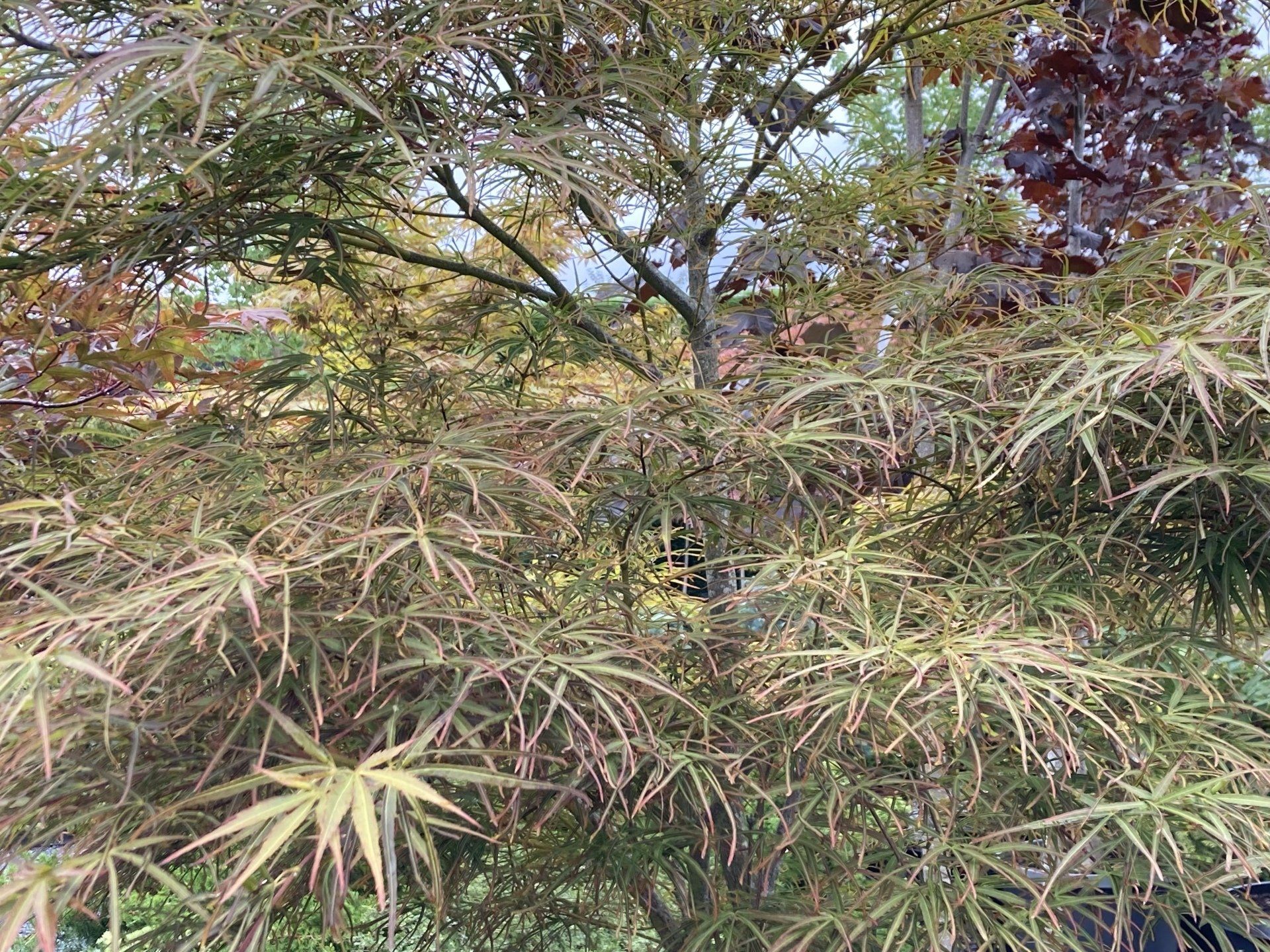
Acer palmatum
'Villa Taranto'
Villa Taranto Japanese Maple
– A beautiful cultivar shows its uniqueness in the spring when it lights up the garden with orange crimson almost rose-colored new foliage that changes to bright green in summer and finally yellow-gold in autumn. Interesting long, narrow, linear foliage. Unique small specimen tree that does great in a container. Matures at 8-10' tall with similar canopy spread. Best color in the moderate sun since it will stay green in shade. Hardy in USDA zones 6-9.
Acer palmatum
‘Trompenburg’
Trompenburg Japanese Maple
– This small upright tree has foliage that emerges dark reddish-purple in spring and late summer brings reddish-green and bronze before turning showy crimson red in fall. Prefers full sun to partial shade. Matures at 15’ tall x 10’ wide. Hardy in USDA zones 5-8.
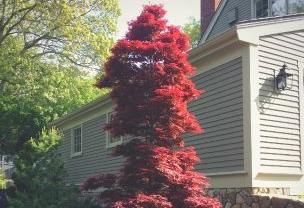
Acer palmatum
‘Twombly’s Red Sentinel’
Twombley’s Red Sentinel Japanese Maple
– This vigorous, upright, red tree develops a columnar habit allowing it to fit into a smaller space than forms with broad canopies. The foliage darkens to a deep, warm red. Matures at 20’ tall x 15’ wide. Prefers full sun. Hardy to USDA zone 5.

Acer palmatum var. dissectum
'Crimson Queen'
Crimson Queen Weeping Red Laceleaf Japanese Maple
– A dwarf tree with delicate, sculptural, cascading branches. Foliage emerges bright crimson red in the spring, deepens to burgundy, and finishes the fall a brilliant scarlet red. It carries its color throughout the entire growing season and needs a sheltered spot protected from strong winds or scorching sun. A perfect focal point for a small garden, entryway or container. Especially nice if placed beside a water feature where it can reflect its sculptural shape. Likes evenly moist soils, acidic with good drainage. Moderate grower reaching 6-10 feet tall and wide. Leaf color is best in filtered light. Hardy in USDA zones 5-8.
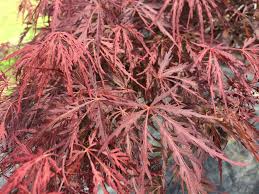
Acer palmatum var. dissectum
'Red Dragon'
Red Dragon Laceleaf Japanese Maple
– An exceptional maple for a small garden or rockery. Foliage is bright scarlet red in spring, turning dark burgundy in the summer, and finally rounding out the show with a flaming scarlet in fall. Definitely the new standard for red-leafed maples. This cascading mound reaches 5-6' in 10 years. Full to Part Sun. Hardy in USDA zones 5-8.
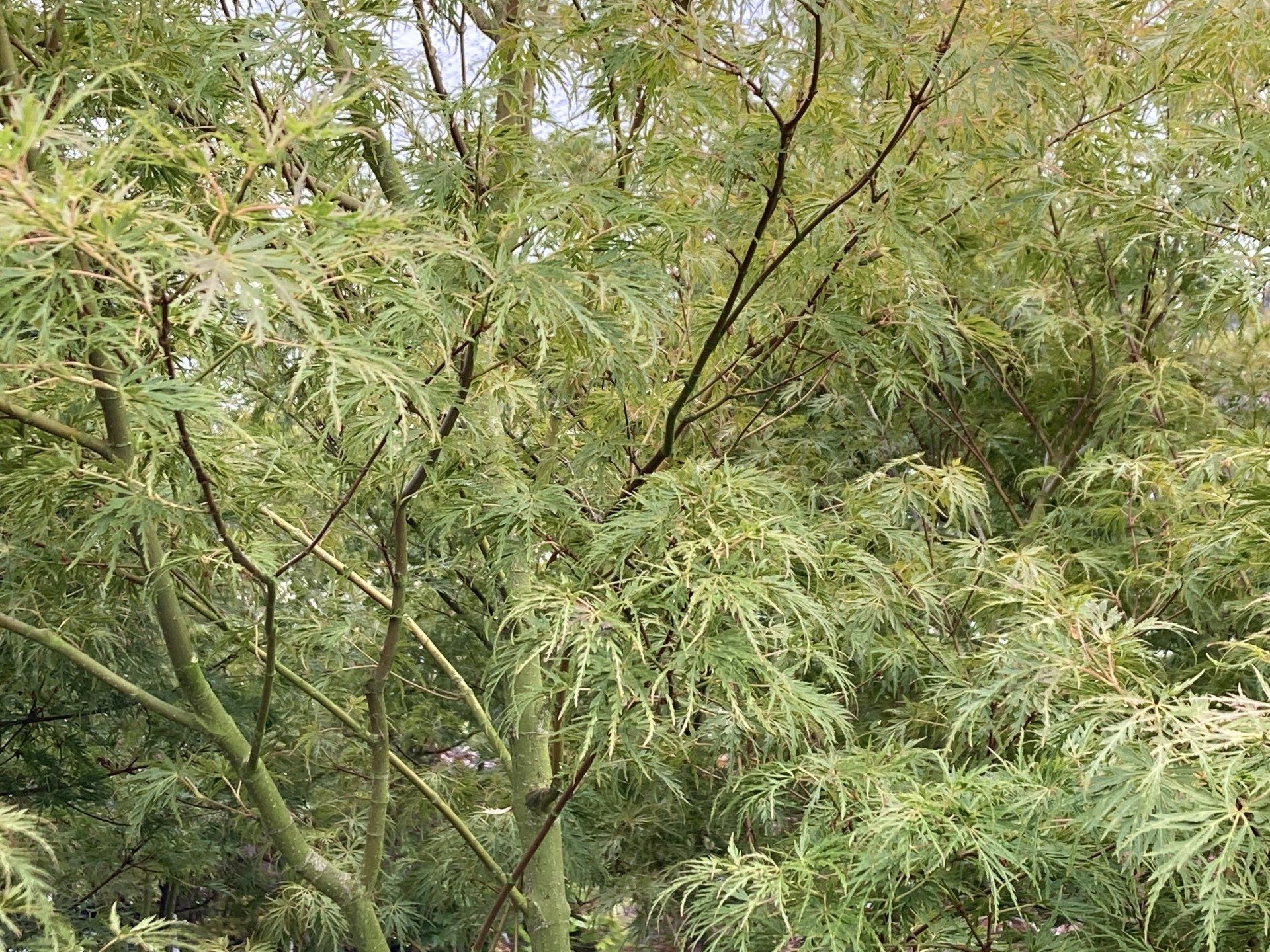
Acer palmatum var. dissectum
'Seiryu'
Seiryu Laceleaf Japanese Maple
– Unusual to see an upright laceleaf maple. Foliage is a pleasing bright green. Fall color is spectacular strong golds to light yellow with a suffusion of crimson. A strong grower in youth, it develops a vase-like shape. Eventually, the tree will reach about fifteen feet high and ten to twelve feet wide. Full Sun to Light Shade. Hardy in USDA zones 6-8.
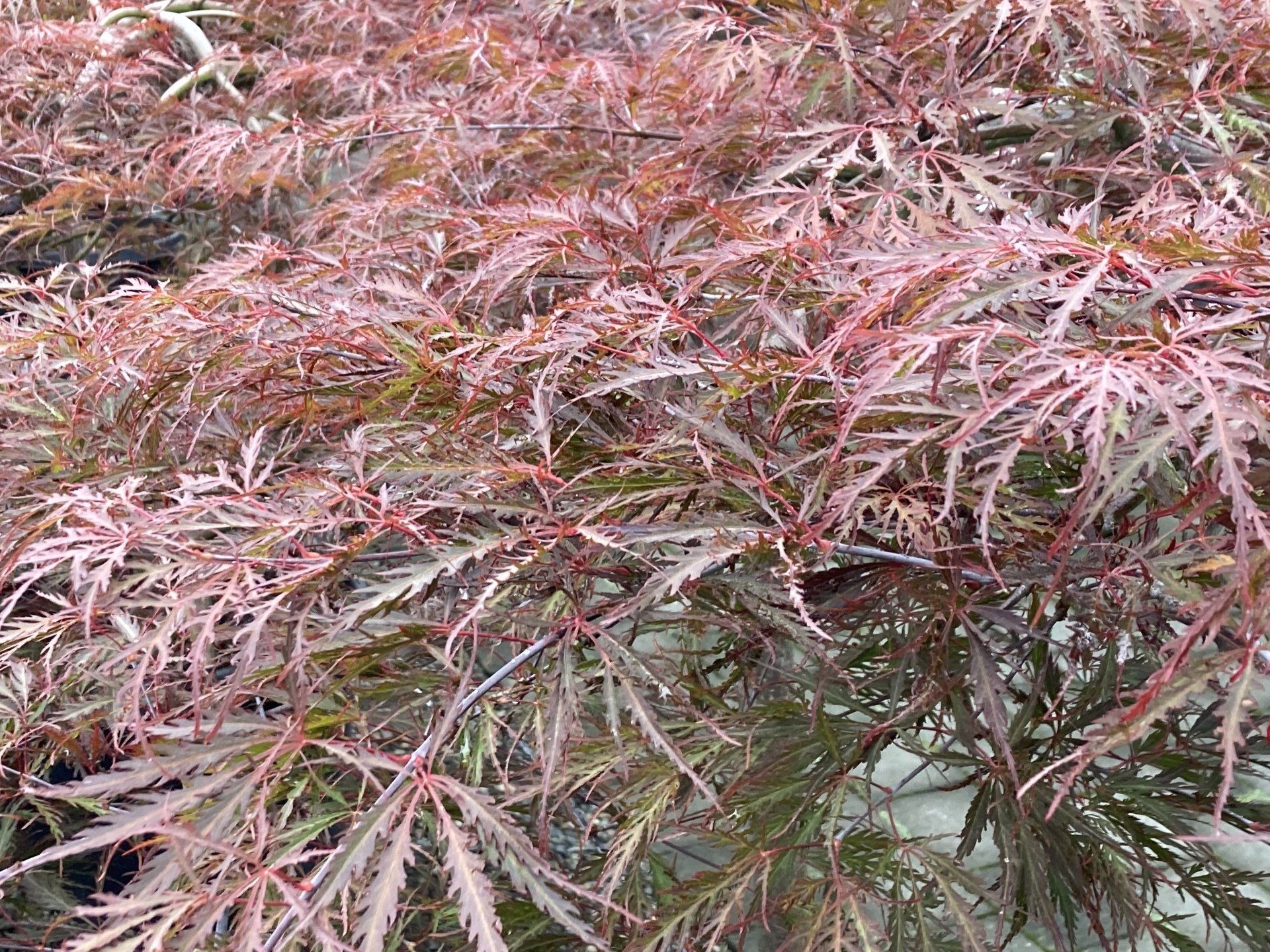
Acer palmatum var. dissectum
'Tamukeyma'
Tamukeyma Laceleaf Japanese Maple
– The new foliage emerges a deep crimson-red unfolding to a beautiful dark purple-red. The color holds on this maple throughout the summer. Fall color is bright scarlet. A graceful weeping habit reaching five to seven feet in ten years. Full Sun. Hardy in USDA zones 5-9.
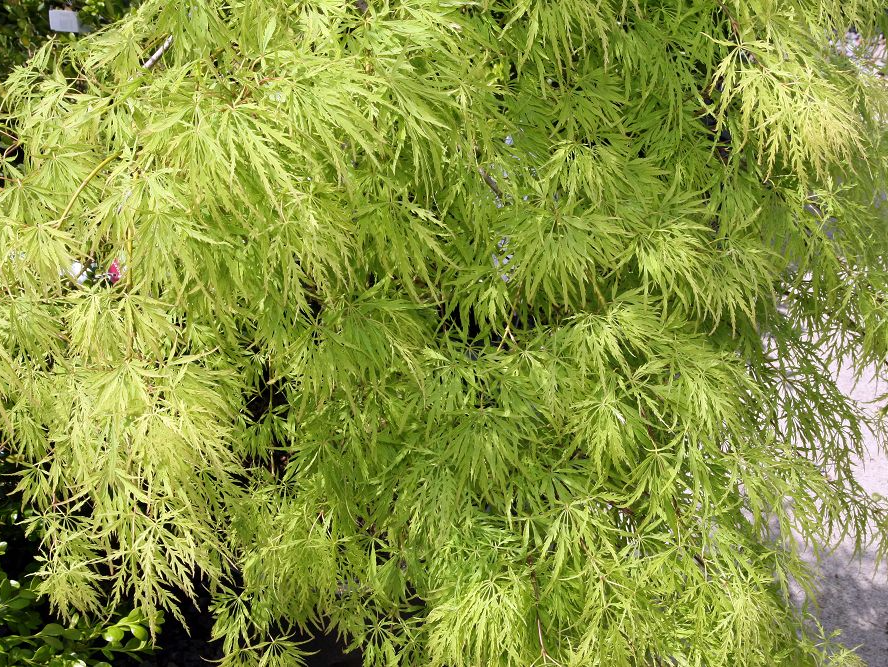
Acer palmatum var. dissectum
'Viridis'
Weeping Green Laceleaf Japanese Maple
- Beautiful, weeping Japanese Maple, especially in the fall, vibrant foliage glows in gold, yellow and red. Exceptional branching architecture for winter interest. Grows to 3-4 feet tall with a 5-7 foot spread in 10 years. Maturing to 6-8 feet tall and wide. Full Sun to Light Shade. Hardy in USDA zones 5-8.
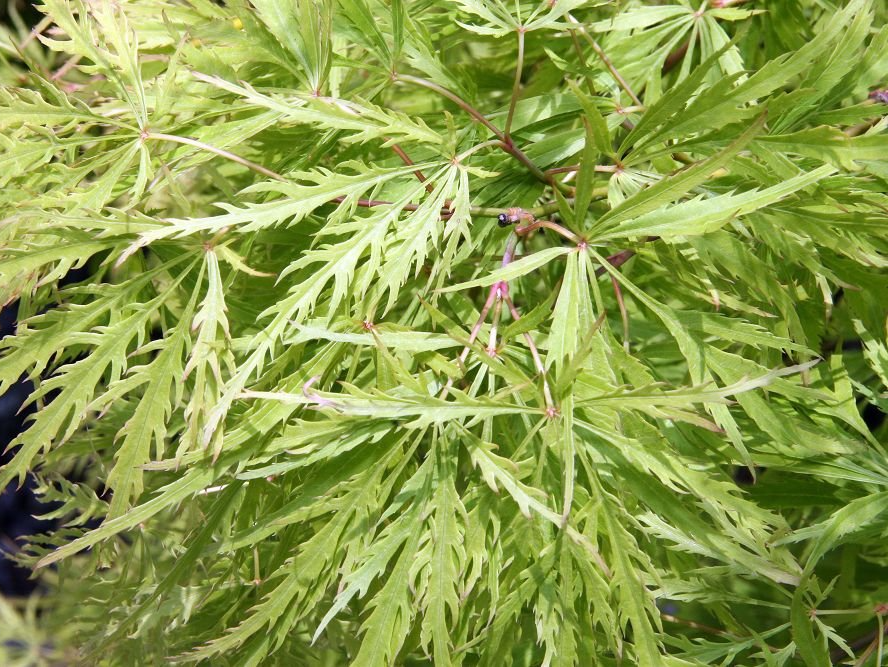
Acer palmatum var. dissectum
'Waterfall'
Waterfall Japanese Maple
– Exciting cascading branches with large green leaves and stunning gold fall color. Makes a great specimen tree or feature it in a container. 8-10 feet tall and 10-12 feet wide. Full to part sun. Hardy in USDA zones 5-8.
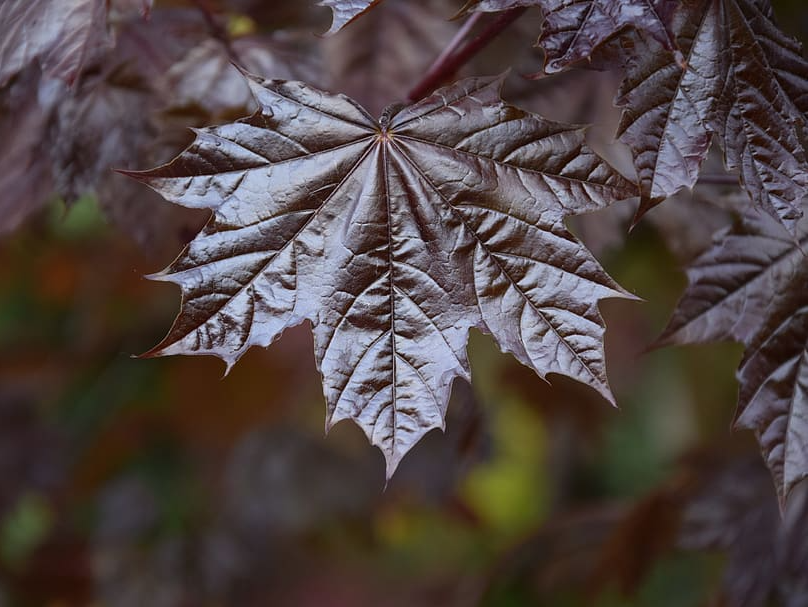
Acer platanoides
'Crimson King'
Crimson King Maple
– This striking tree has purple-maroon colored leaves for most of the growing season and changes to reddish-orange in the fall. Flowers are maroon-yellow and seeds are also purple. This handsome shade tree reaches 18 to 20 feet tall in ten years. Maturing at 40 feet tall with a similar spread. Prefers full sun. Hardy to USDA zone 4.
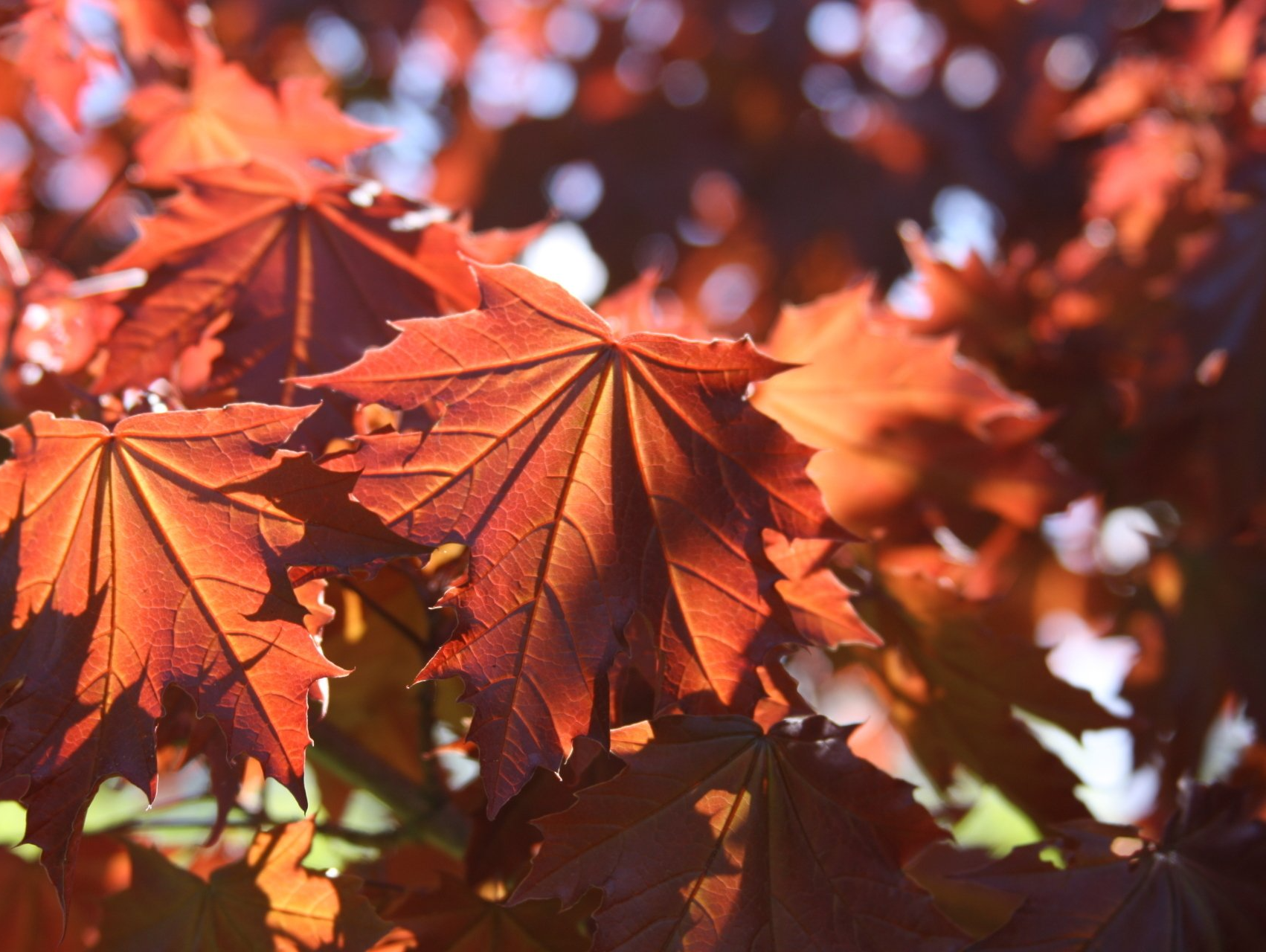
Acer platanoides
'Crimson Sentry'
Crimson Sentry Maple
– A narrow, upright, pyramidal tree. Dark purple foliage spring and summer. Very dense, initially columnar, later pyramidal to oval in shape. Leaves alternate, simple, purple-maroon; reddish-bronze in fall. Moderate growth rate reaching 10-12 feet tall in 5-8 years maturing to 25 feet tall and 18 feet wide. Full Sun. Hardy in USDA zones 3-7.
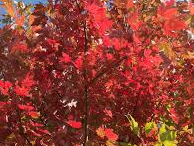
Acer rubrum
'Armstrong'
Armstrong Red Maple
- Brilliant fall color usually orange-red to yellow- orange. Ideal street tree, fast-growing narrow, columnar tree. Grows to 15 feet tall and 4 feet wide in 4 years. Will reach 50 feet tall with 15' spread. Prefers full sun. Hardy in USDA zones 4-9.
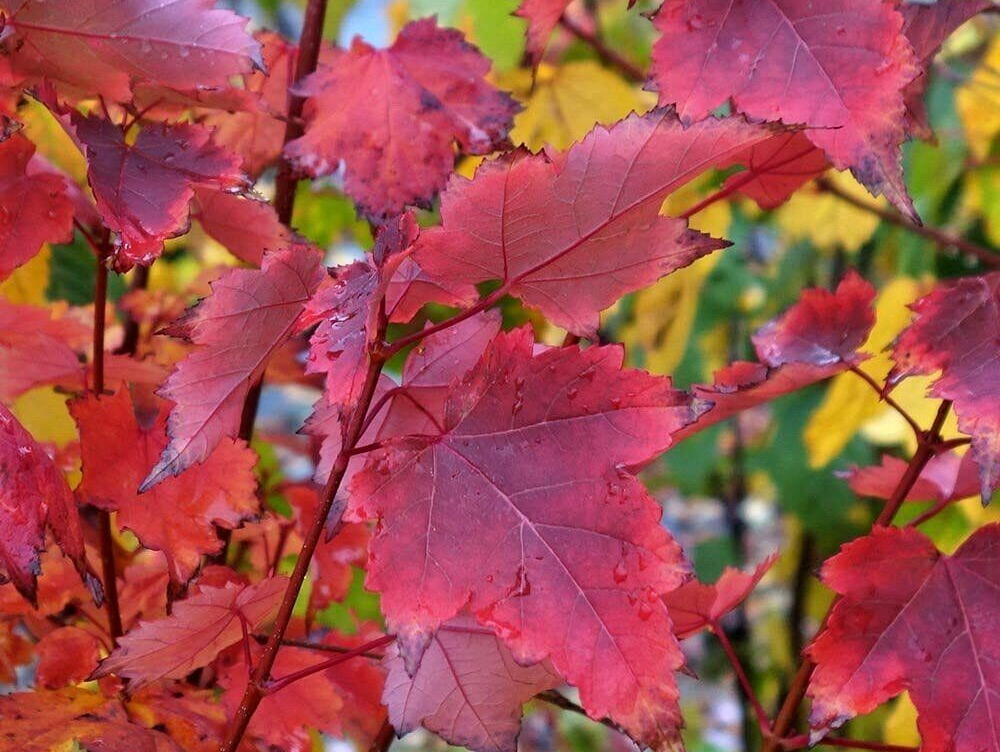
Acer rubrum
‘Brandywine’
Brandywine Red Maple
– Leaves are green above and green with a blue-gray bloom beneath. Fall color is a bright red that gradually turns reddish-purple. Matures at 35’ tall x 25’ wide. Prefers full sun. Hardy in USDA zones 4-9.
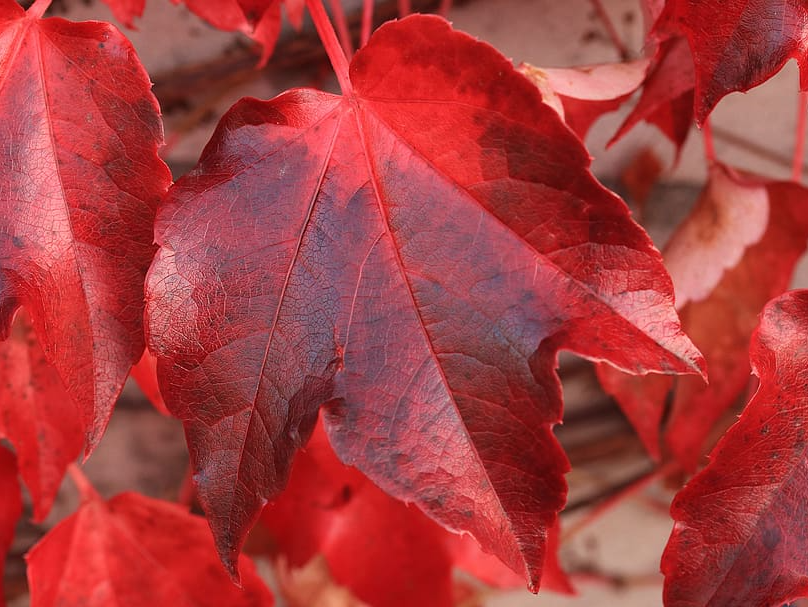
Acer rubrum
'October Glory'
October Glory Red Maple
– Good oval-rounded form. Excellent specimen for lawn or street tree. Brilliant orange to red fall color. Grows to 10-12 feet tall in 5-7 years. Reaching 40 feet tall by 35 feet wide at maturity. Prefers full sun. Hardy to USDA zone 4b.

Acer rubrum
'Red Sunset'
Red Sunset Maple
– A deciduous tree, pyramidal to rounded outline, fast -growing. Leaves opposite, simple, thick, strongly 3-lobed, dark, glossy green, fall foliage is brilliant orange-red to red. Colors earlier and is more cold hardy than October Glory Maple. It is also very tolerant of a wide range of soils and has shown high tolerance to flooding. Matures at 40-50 feet tall by 30-40 feet wide. Prefers Sun. Hardy to USDA zone 4.
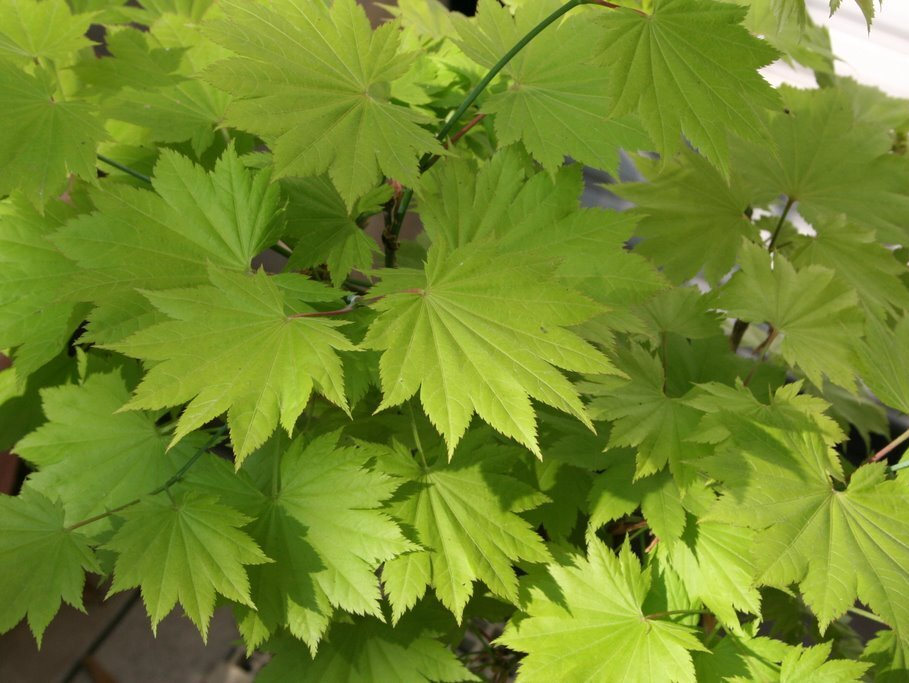
Acer shirasawanum
'Aureum'
Golden Full Moon Maple
– This showy maple has yellow-green foliage in spring and summer turning an attractive orange-red in the fall. Prominent red flowers and seeds are quite lovely. Must be in light of dappled shade, full sun will scorch. 16-20 feet tall and wide. Hardy in USDA zones 5-7.
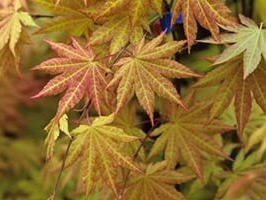
Acer shirasawanum
'Autumn Moon'
Autumn Moon Full Moon Maple
– Emerges an unusual burnt-orange with green undertones. Stays chartreuse through the summer and then changes to bright orange-red fall color. Perfectly suited for small gardens as it only reaches six to ten feet tall and wide. Grow in full sun for best color. Hardy in USDA zones 5-7.
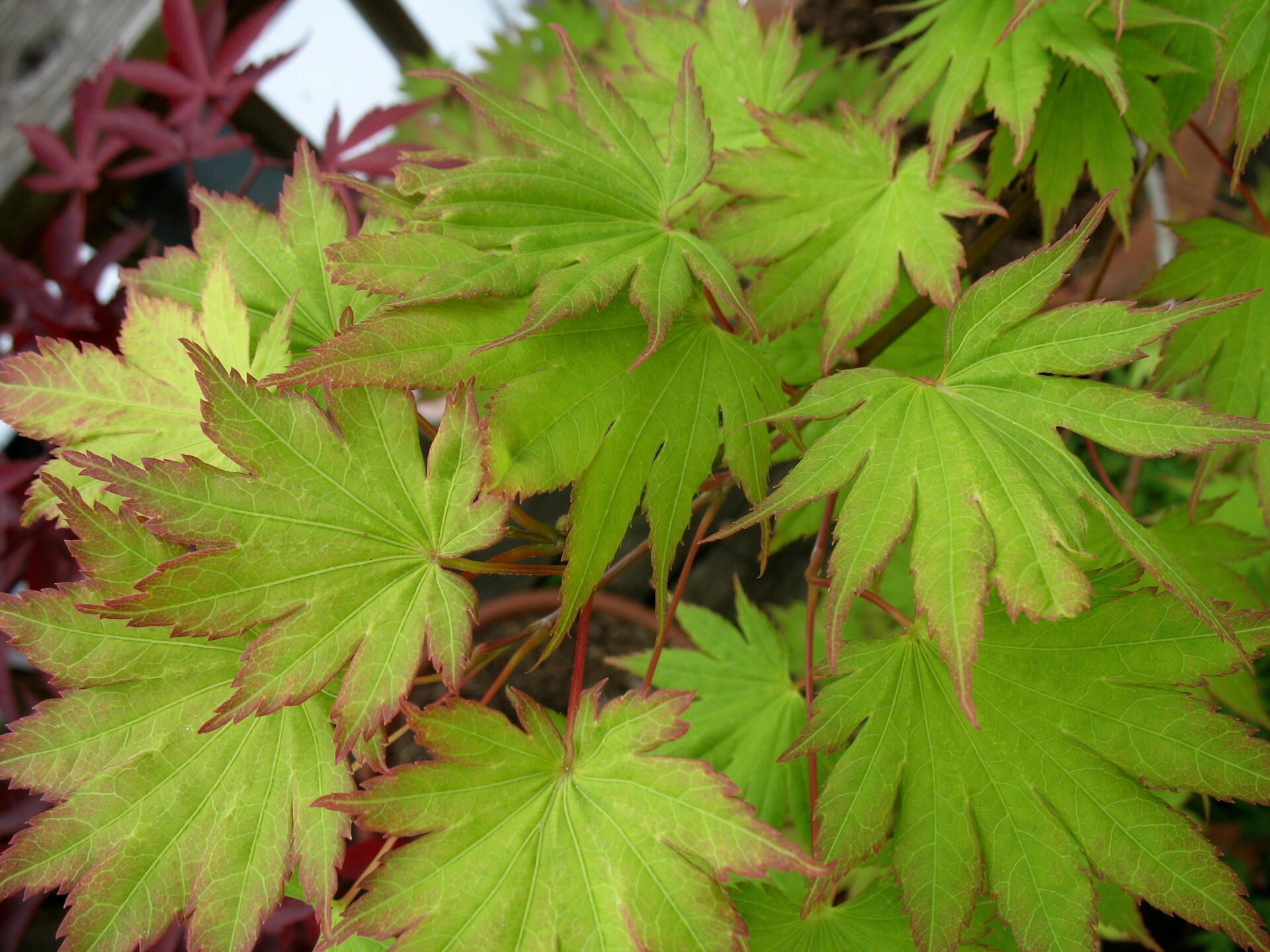
Acer shirasawanum
‘Palmatifolium’
Palmatifolium Full Moon Maple
– The foliage on this beautiful specimen is palm-shaped in a medium green in spring aging to burnished russet to red in fall. Prefers partial sun. Matures at 10-12’ tall x 8-10’ wide. Hardy in USDA zones 5-9.
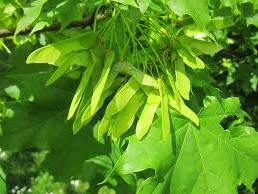
Acer x pseudosieboldianum
‘Arctic Jade’
Arctic Jade Korean Maple
– This hybrid maple has large deeply cut leaves in medium green that age to orange-red in fall. Matures at 20’ tall x 15’ wide. Prefers partial sun. Hardy in USDA zones 4-8.
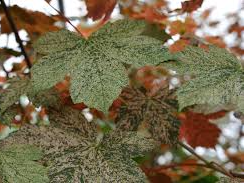
Acer x pseudosieboldianum
‘Eskimo Sunset’
Eskimo Sunset Maple
– In spring the leaves emerge orange-pink and mature to a green that is splashed with cream and pink markings. The underside of the leaves is purple. Matures at 30’ tall x 20’ wide. Prefers full to partial sun. Hardy to USDA zone 4.
Acer x pseudosieboldianum
‘Northwind’
Northwind Maple
– This tree was bred to tolerate harsh and dramatic weather shifts that occur in many regions of the country. The leaves emerge red in spring changing to green by midsummer, followed by a dramatic orange-red in fall. Matures at 20’ tall x 15’ wide. Prefers full to partial sun. Hardy to USDA zone 4.
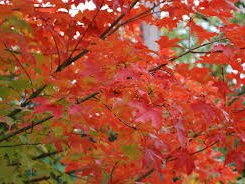
Acer truncatum
Pacific Sunset ('Warrenred')
Pacific Sunset Maple
– A broadleaf deciduous tree with an upright spreading crown. Leaves are very glossy dark green above and lighter green below. The fall color ranges from yellow-orange to red. Pacific Sunset™ in comparison to a related cultivar, Norwegian Sunset™, is slightly shorter, it has a finer branch structure, spreads more, and has brighter fall color. It is more heat and drought tolerant than a Norway Maple. Grows to 30 feet tall and 25 feet wide. Prefers full sun to part shade. Hardy to USDA zone 4b.
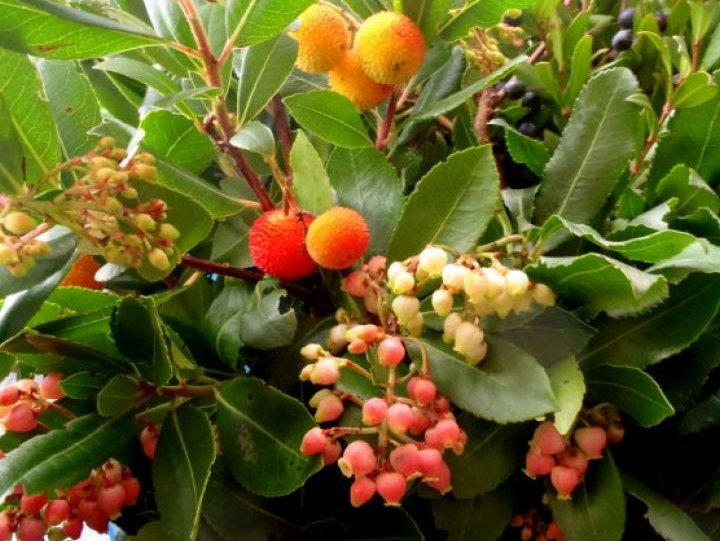
Arbutus unedo
‘Compacta’
Compact Strawberry Tree
– A four-season evergreen shrub with outstanding flowers fruit leaves and bark. Will Reach 6 feet tall with an equal spread. Full Sun, light or open Shade. Hardy in USDA zones 7-9.
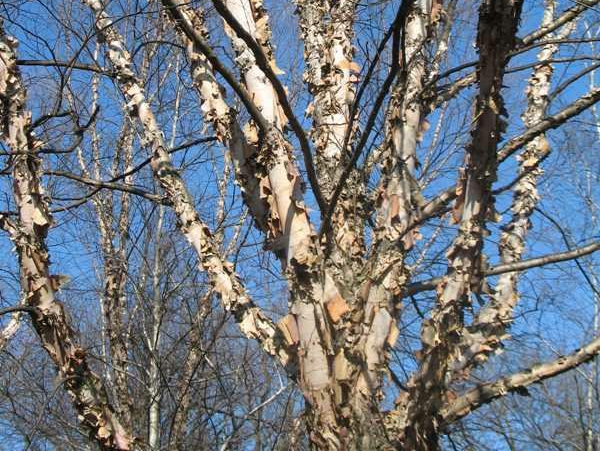
Betula nigra
'Heritage'
Heritage River Birch
– A graceful tree, known for its multicolored salmon-cream, peeling bark. A superior selection. Excellent yellow fall color. Pruning is not necessary except to remove damage. Pyramidal to oval headed in youth and often more rounded in form at maturity. This tree is very handsome when grown as a multi-stemmed specimen. Grows best in moist, slightly acidic, well-drained, soil but will also tolerate wet soils. The 10-year height is 12 to 15 feet tall, maturing at 30-40 feet over 20 years. Full Sun to Part Shade. Hardy in USDA zones 4-9.
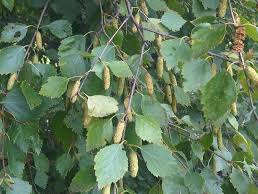
Betula pendula
'Youngii'
Young's Weeping Birch
– The light green foliage turns yellow in fall and is attractive year-round. In the winter the colorful, peeling bark and thin graceful branches are stunning. Young trees have dark-colored bark until their trunks reach 1 inch around. Plant against a darker background or green lawn to highlight pale trunks. Once established, tolerates some heat and dry spells but water deeply and often, around shallow roots till established. Prune in winter only after leaves have formed, to prevent sap bleeding. Grows to 10 -12 feet tall and wide. Prefers full sun. Hardy in USDA zones 2-7.
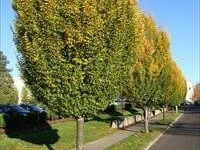
Carpinus betulus
'Fastigiata'
Narrow European Hornbeam
– Provide extra water during summer until the tree becomes established, about two growing seasons. Once established it is very drought tolerant. For a hedge, set plants 3 to 6 feet on center and shear as necessary. This narrow-growing selection of European hornbeam grows slowly, reaching 20 to 25 feet tall in ten years with a width of 8 to 10 feet. Mature trees can reach 40 to 50 feet tall and broaden out to 25 to 30 feet. Plant in Full Sun or Partial Shade. Hardy in USDA zones 4-8.
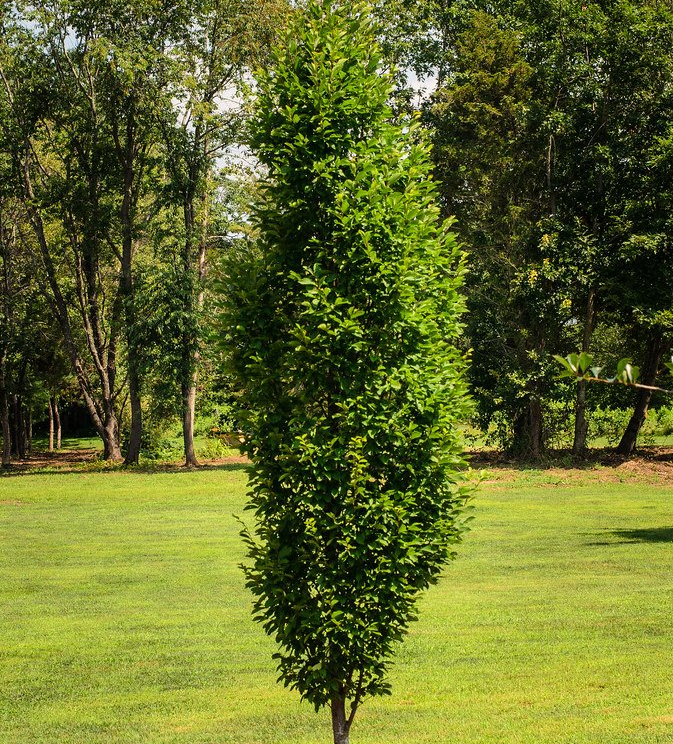
Carpinus betulus
‘Fran Fontaine’
Fran Fontaine Hornbeam
– The sleek columnar tree has deep green leaves that are golden in fall. Matures at 20-25’ tall x 6-8’ wide in ten years. Prefers full sun. Hardy in USDA zones 4-8.
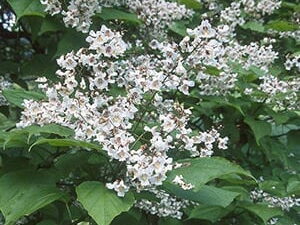
Catalpa bignonioides
Indian Bean Tree
– A medium-sized deciduous tree with brown to gray bark, maturing into hard plates or ridges. The short thick trunk supports long and straggling branches which form a broad and irregular head. Leaves are large and heart shaped and appear late and as they are full grown before the flower clusters open, adding much to the beauty of the blossoming tree. Flowers are white trumpet shaped, white with yellow spots inside. In the northern states, it is a late bloomer in June or early in July. The fruit is a long, thin, bean-like pod that often stays attached to the tree during winter. Matures at 30-40 feet tall. Prefers sun and partial shade. Hardy to USDA Zone 5.
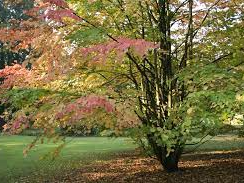
Cercidiphyllum japonicum
Katsura Tree
– Grows best in fertile, humus-rich, well-drained soil. Fall color and growth is best in planted in full sun, but the tree also grows well in part shade. It appreciates regular summer watering during dry spells. This is especially important for its first two growing seasons; if it is planted in full sun. Mulch applied in spring help keeps its roots cool in summer. It is vase shaped, with arching branches and multiple trunks. Reaching about 15 to 25 feet tall with a slightly less spread in ten years. It matures at 40 to 60 feet by about 30 to 50 feet wide. Best in Full Sun. Hardy in USDA zones 4-8.
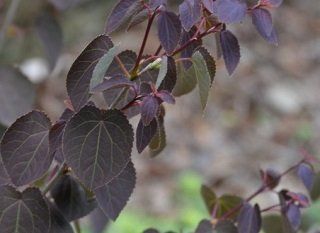
Cercidiphyllum japonicum
'Red Fox'
Red Fox Katsura Tree
– A compact, columnar tree with heart-shaped leaves, the foliage on this slightly more compact form of Katsura emerges a reddish bronze, taking on green tones in summer and orange and yellow shades in fall. It has only recently become available, it is estimated that it will reach a height of 30 feet tall and 20 feet wide. Prefers full sun. Hardy in USDA zones 5-8.
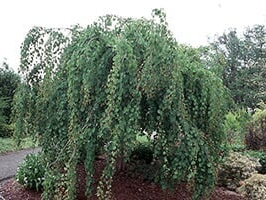
Cercidiphyllum japonicum
'Pendula'
Weeping Katsura Tree
– A deciduous tree, an eye-catching specimen, its weeping branches form an attractive, dense crown. Beautiful blue-green foliage turns bright yellow in fall. Grows best in moist, well-drained soil, pH adaptable. Slow growing to 15 feet tall and 10-15 feet wide. Prefers full sun. Hardy to USDA Zone 4.
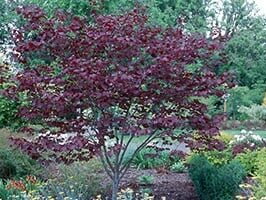
Cercis canadensis
'Forest Pansy'
Forest Pansy Redbud
– A deciduous tree, spreading, horizontally tiered reddish branches. Heart-shaped leaves are glossy, red - purple when young, more maroon as they mature, and then becoming purple-green or even dark green in summer. Fall color may be a mixture of green, red, and orange. Small rosy-purple flowers in spring before leaves appear. Fruit (pods) are more reddish than brown. Grows to 20 feet tall and 25 feet wide. Prefers Sun. Hardy to USDA zone 4.
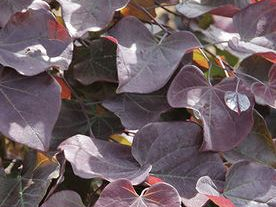
Cercis canadensis
‘Ruby Falls’
Ruby Falls Redbud
– Rich plum heart shaped leaves are borne on this weeping Redbud tree. Pink to lavender blooms are offered in spring. Matures at 6-8’ tall x 4’ wide. Prefers full sun. Hardy in USDA zones 6-8.
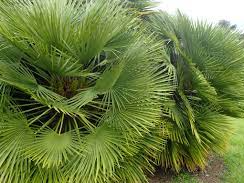
Chamaerops humilis
Mediterranean Fan Palm
– This drought tolerant shrub to tree shaped palm offers large fan shaped leaves. Matures at 6-8’ tall and wide. Prefers full sun and well-drained soil. Hardy in USDA zones 8-11.
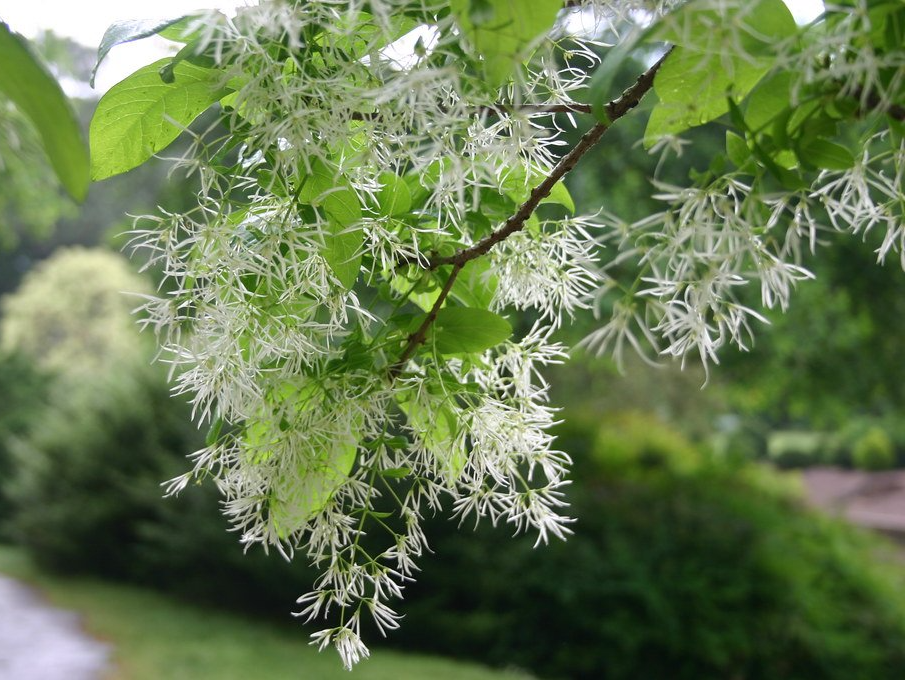
Chionanthus virginicus
Fringe Tree – Few trees bring greater season-long charm to the landscape. This small tree has it all, attractive snow-white flowers, deep furrowed bark, glossy green foliage, and a small, rounded habit. In June, it is in full bloom is a sight to behold. Because it is slow-growing, it is excellent used as a container plant. Grows best in any fertile, well-drained soil. Drought tolerant once established. Chionanthus virginicus
is a spreading, deciduous shrub or small tree that at maturity reaches 15 feet in height and almost as wide. Full Sun. Hardy in USDA Zones 6-8.
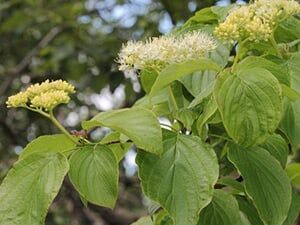
Cornus alternifolia
Pagoda Dogwood
– Native to eastern North America, it is a small, deciduous tree that is noted for its beautifully layered, low branches, it should be planted where it has plenty of room to spread. Pagoda dogwood prefers even moisture and humus-rich, well-drained soil. Grows to 15 feet tall and 12 feet wide in ten years, maturing at about 25 feet high and 30 feet wide. Plant in full sun or bright shade. Hardy USDA zones 4-8.
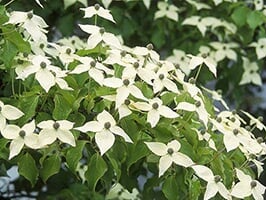
Cornus kousa
Korean Dogwood
– Deciduous tree, vase-shaped in youth, strong horizontal lines with age, exfoliating grey, tan and brown bark. Leaves have a drawn out tip, dark green in summer, purplish-red or scarlet in fall. "flowers" are creamy-white, the blooms appear after the foliage emerges, The fruit is initially green but ripen to pink or red, are spherical and are favored by birds. Needs acidic, well-drained soil. More drought resistant and possibly less disease susceptible than C. Florida. Matures at 15-18 feet tall and wide. Sun to light shade, Hardy to USDA Zone 5.
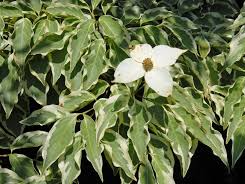
Cornus kousa
"Samaritan" ('Samzam')
Variegated Korean Dogwood
– Eye catching creamy white variegated leaves, blooms white flower bracts in May through June. Foliage turns radiant pink and has rich burgundy hues in autumn. Will mature at 20-25 feet tall and wide. Partial Sun. Hardy in USDA Zones 5-8.
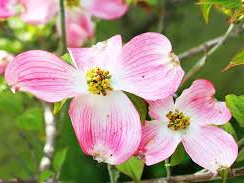
Cornus kousa
'Satomi'
Satomi Dogwood
– An elegant deciduous tree. Pink Flowers May-June. Red Fruit in the fall when the leaves turn reddish-purple. The bark is a multicolored mosaic of grey, tan and rich brown. Grows to 15-18 feet tall and wide. Prefers Sun to Light Shade. Hardy to USDA Zone 4.
Cornus kousa
‘Summer Gold’
Summer Gold Dogwood
– A small upright tree growing upright when young and becoming broader as it matures. In spring, the foliage is a soft yellow, brightening up to gold. The autumn color is orange-red. Matures at 12’ tall x 12’ wide. Hardy to USDA zone 5.
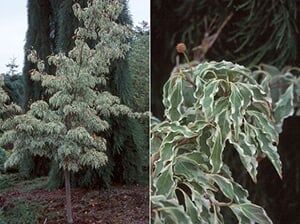
Cornus kousa
'Wolf Eye'
Variegated Chinese Dogwood
– Leaves are narrow, with gray-green center and prominent white margin. In spring, it is covered with star-shaped white flowers. Followed by red-orange fruit in summer. Pink to red fall color. Excellent small specimen tree. Slow growing, reaching 15-20 feet tall with an equal spread. Best in part shade; reportedly less susceptible to burning (scorch) than many variegated selections. Hardy to USDA Zone 5.

Cornus mas
'Golden Glory'
Golden Glory Cornelian Cherry Dogwood
– This is a deciduous small tree with an oval-shaped crown. It grows best in fertile, humus-rich, well-drained soil. It tolerates poor soils as long as they are well-drained. If it is growing in humus-rich soil, it is drought-tolerant once established. This moderate grower reaches 10 feet high and wide in ten years, maturing at about 15 feet high and wide. Prefers full sun to part shade. Hardy to USDA Zone 4.
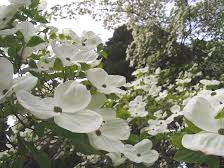
Cornus
'Eddie's White Wonder'
Eddie's White Wonder
- Pacific Dogwood is a deciduous tree, A hybrid of the Pacific Northwest native, and Cornus florida. A striking display of big beautiful white flowers in the spring. Leaves are variegated, streaked, and spotted with gold and turn red in the fall. Small red fruits decorate its winter branches. Best in well-drained, acid soils high in organic matter. Will reach 25 feet tall and 20 feet wide. Prefers part shade. Hardy to USDA Zone 7.
Cornus
‘Rosy Teacups’
Rosy Teacups Dogwood
- A cross of C. kousa x C. nutallii with pink autumn foliage. It features long-lasting, pink blooms with magenta edges in the spring, and the leaves turn red in the fall. Matures at 8’ tall x 10’ wide. Prefer full to partial sun. Hardy in USDA zones 6-8.
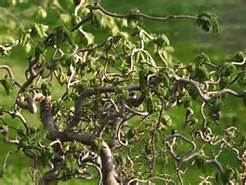
Corylus avellana
'Contorta'
Harry Lauder's Walking Stick
- A deciduous shrub or tree. Artistically contorted stems provide great interest in the winter garden. Numerous yellow-green catkins appear in fall and winter. Leaves are also slightly twisted. Often grafted on to a species rootstock, the American filbert, C. Americana. Prefers moist, well-drained soil. Grows to 8-10 feet tall and wide. Sun to part shade. Hardy to USDA Zone 4.
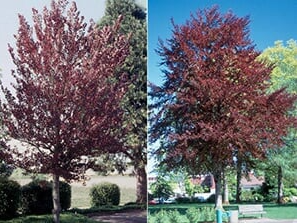
Fagus sylvatica
'Purpurea'
Purple Beech
– True purple leaf beech, young leaves are deep black-red, Changing to purple- green in summer. A large graceful ornamental tree. Native to Europe. Beeches prefer moist, well-drained, acidic soil, does not like excessively wet soils full sun best with this cultivar which has a shallow, wide root system. Prune in early summer or early fall, if needed. Grows to 9-12 feet tall in 10 years, maturing at 35 feet tall in 20 years. Full Sun. Hardy to USDA zone 4.
Fagus sylvatica
'Purpurea Pendula'
Weeping Purple Beech
– A broad mushroom-shaped, weeping, purple-leaf form that never becomes too large. Beeches prefer moist, well-drained, acidic soil; does not like excessively wet soils full sun best with this cultivar, which has a shallow, wide root system. Prune in early summer or early fall, if needed. Leaves fade purple-green in summer. Matures at 10 feet tall with equal spread. Full Sun. Hardy in USDA zones 4-7.
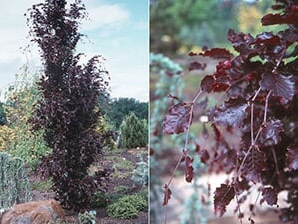
Fagus sylvatica
'Red Obelisk'
Red Obelisk Beech
– A narrow specimen for a tight spot, or as a vertical accent. Dark purple dissected leaves add interesting color, and texture to the landscape. Beeches prefer moist, well-drained, acidic soil, and does not like excessively wet soils. Full sun is best with this cultivar. Prune in early summer or early fall, if needed. Grows to 10 feet tall and 3 feet wide in 12 years. Reaching 40 feet tall at maturity. Prefers full sun to shade. Hardy in USDA zones 4-7.

Fagus sylvatica
'Tricolor'
Tricolor Beech
- A beautiful specimen tree. In spring foliage is a dazzling mix of purple, pink, and white. A unique, impressive color scheme. Beeches prefer moist, well-drained, acidic soil, and does not like excessively wet soils. It does best in full sun. Slow grower, will reach 30 feet tall, 20 feet wide. Best to provide light shade. Hardy in USDA zones 4-7.
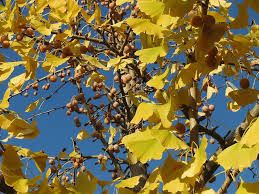
Ginkgo biloba
'Autumn Gold'
Autumn Gold Maidenhair Tree
– One of the most beautiful deciduous trees. This species evolved over 200 million years ago! Handsome symmetrical oval shape. The unique fan-shaped leaf displays. Ginkgo prefers deep sandy soil and full sun. They are drought tolerant once established. They also tolerate urban situations, pollution, and salt spray. In general, Ginkgo has very variable habits of growth, so one of the attractions of this variety is that it is relatively symmetrical, forming a broadly pyramidal tree reaching 12 to 15 feet high and 6 feet wide in ten years. Reaches 50 feet at maturity. Prefers full sun. Hardy in USDA zone 3-9.
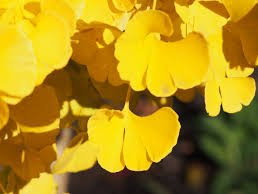
Ginkgo biloba
‘Mariken’
Mariken Maidenhair Tree
- This dwarf low spreading cultivar grows very slowly, reaching a mature size of 3’ tall x 8’ wide. Fall color is golden. Prefers full to partial sun. Hardy in USDA zone 3-8.
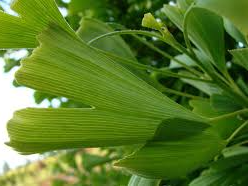
Ginkgo biloba
'Saratoga'
Saratoga Maidenhair Tree
– A most spectacular shade and ornamental tree. Rich yellow fall color. A distinctive specimen with elongated leaves. Likes deep sandy soil, adaptable to pH and most other conditions, tolerant of pollution, salt air and heat. Prefers to be pruned in spring. Grows to 10-15 feet tall over 10 to 12 years. Reaching 40 feet tall at maturity. Prefers full sun. Hardy to USDA Zone 3.
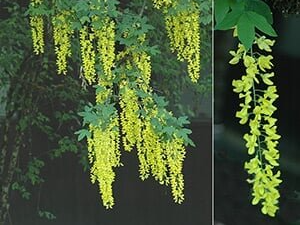
Laburnum x watereri
Golden Chain Tree
– Golden chains of lightly scented flowers cascade from branches May- June, producing a spectacular landscape effect. Upright, compact shape. 12-15 feet tall and 8-10 feet wide. Prefers sun to part shade. Hardy in USDA zones 5-7.
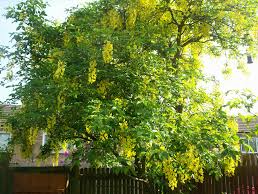
Laburnum x watereri
‘Vossi’
Vossi Golden Chain Tree
– This graceful tree is known for its golden flower clusters borne in spring that are reminiscent of wisteria blooms. Foliage is a medium green aging to gold in fall. Prefers full sun. Matures at 20’ tall x 15’ wide. Hardy in USDA zones 6-8.
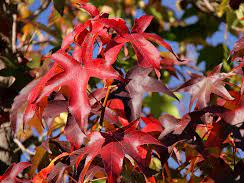
Liquidambar styraciflua
'Slender Silhouette'
Slender Silhouette Sweetgum
- A lovely pyramidal tree, with star-shaped leaves. Turns gorgeous shades of yellow, orange, red and purple into late fall. Grows 2-3 feet per year reaching 60 feet at maturity. Prefers full sun. Hardy in USDA zones 5-9.
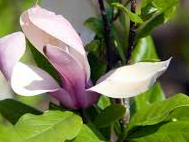
Magnolia
‘Ann'
Ann Magnolia
– This beautiful tree bears pink-purple tulip shaped blooms in spring. Medium green foliage ages to gold in fall. Matures at 10-15’ tall x 12’ wide. Prefers full sun. Hardy in USDA zones 4-9.
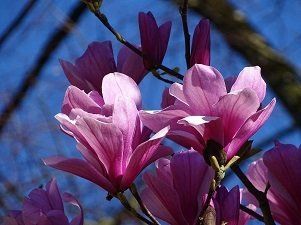
Magnolia
‘The Girls’
The Girls Magnolia -
This series of magnolia varieties ('Ann', 'Betty', 'Susan', 'Judy', 'Randy', Ricki') have a small oval, shrub-like form. They are a cross between Magnolia liliflora 'Nigra' and Magnolia stellata 'Rosea'. These hybrid magnolias bloom in a range of shades of pink and reach an average height and width of 15'. They are deciduous with medium green leaves emerging after the blooms. Prefers partial to full sun in moderately moist, rich soil. Hardy in USDA zones 4-8.

Magnolia
‘Vulcan’
Vulcan Magnolia
– This graceful tree bears upright, dark rose-colored blooms in spring. Medium green foliage becomes golden in fall. Matures at 15’ tall x 10’ wide. Prefers full sun. Hardy in USDA zones 5-9.
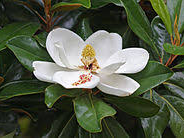
Magnolia grandiflora
‘Victoria’
Victoria Evergreen Magnolia
– This glorious tree bears large glossy green leaves are felted rust colored underneath. Large fragrant creamy white blooms in summer. Matures at 18’ tall x 12’ wide in ten years. Prefers full sun. Hardy in USDA zones 7-9.

Magnolia x loebneri
‘Leonard Messel’
Leonard Messel Magnolia
– This beautiful small tree has rosy pale to medium pink blooms in late spring and medium green foliage that turns gold in fall. Matures at 10-15’ tall x 12’ wide. Prefers full sun. Hardy in USDA zones 5-9.

Magnolia Stellata
‘Royal Star’
Royal Star Magnolia – This star magnolia offers white multi-petaled tassel-like blooms in spring. The medium green foliage turns a rich golden in fall. Matures at 10-15’ tall x 10-12’ wide. Hardy in USDA zones 4-9.
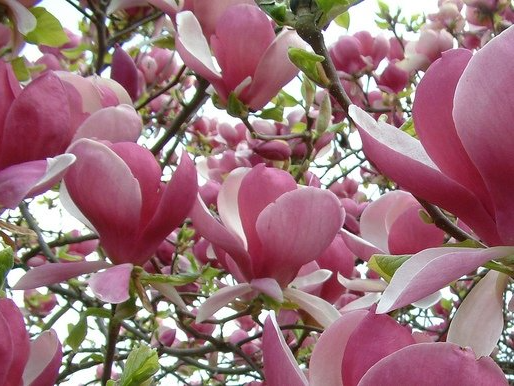
Magnolia x soulangiana
'Rustic Rubra'
Rustic Rubra Saucer Magnolia
Large cup-shaped, pinkish purple, fragrant flowers open in early spring before leaves emerge. One of the spring’s greatest spectacles. Excellent specimen. Grows 10-15 feet tall in 10 years, reaching 20-30 tall and wide. Sun. Hardy to USDA zone 4.
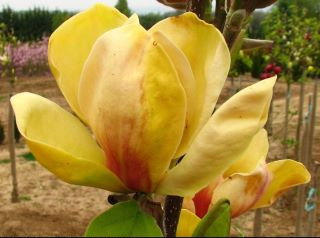
Magnolia
'Sunsation'
Sunsation Magnolia
– Large tulip-shaped blooms that blush with shades of gold and pink. Flowers are replaced with large green leaves. The narrow, upright, form is an excellent vertical accent or shade tree. 15 to 20ft tall and 8 to 10ft wide. Sun. Deciduous. Zone 5-9
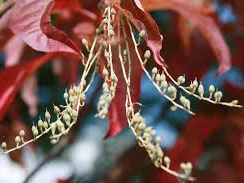
Oxydendrum arboreum
Sourwood Tree
– This tree grows best in fertile, well-drained soil. It requires regular watering during summer dry spells as it has a relatively fine root system. Clusters of fragrant, lily-of-the-valley-like white flowers in mid-summer. Brilliant red fall color. Irregular crown with drooping branches. This beautiful tree thrives in full sun. In our region, sourwood is a slow-growing, deciduous tree to about 20 to 25 feet high and about 10 to 15 feet wide. Hardy in USDA zones 5-9.
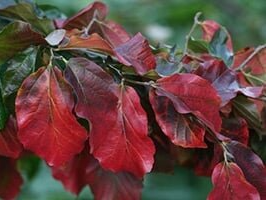
Parrotia persica
Ironwood Tree
- A tree with four seasons of interest, this durable tree is drought tolerant. It grows fastest and has the best fall color in full sun. Give it room to spread and show off its unique branching pattern. Bark exfoliating, producing a mosaic of green, white and brown. Leaves are dark green in summer; yellow, orange to brilliant red in fall. Flowers without petals have showy red stamens, appear before leaves. Fruit is a brown, 2-valved capsule. Grows in ten years to 10 to 15 feet tall and wide. They reach 20 to 40 feet high and wide at maturity. Prefers well-drained, slightly acid, loamy soils. Full sun to light shade. Hardy to USDA zone 5.
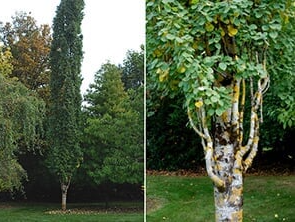
Populus tremula
'Erecta'
Swedish Columnar Aspen
– Used in the landscape for screening or as a specimen tree planted up alongside a tall building. As with Quaking Aspen, the leaves feature the same rustling sounds as they blow in the wind providing a soothing sound in the landscape. The branches ascend almost parallel to the trunk. This makes for a tree that is shaped like a candle flame. The leaves are ovate to nearly round in shape, and 3” long. The leaf margins are serrated and glossy green on the topside and whitish underside. In the fall the leaves turn yellow with orange and red mixed in. Fast-growing, reaching 40 feet tall and 10 feet wide at maturity. Prefers Full Sun. Hardy to USDA Zones 2-7.
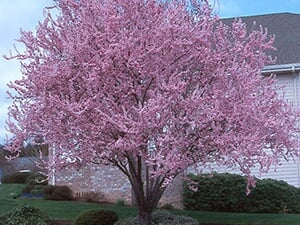
Prunus cerasifera
'Thundercloud'
Thundercloud Flowering Plum
- Grown for its red foliage which is borne on a fast-growing and upright-spreading tree. A small tree, single pink fragrant flowers appear in April, through the summer months the foliage retains its reddish color/deep purple color. In the Pacific Northwest this species typically does not bear fruit. Grows 15-20 feet tall and wide. Full Sun. Hardy to USDA zone 5.
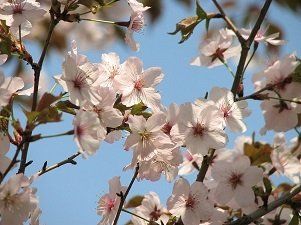
Prunus incisa
‘Little Twist’
Little Twist Flowering Cherry
– This dwarf cherry tree has zigzagging branches on a compact upright shape. Delicate pink blooms are borne in spring and followed by light to medium green foliage. Prefers full sun. Matures 4’-6’ tall x 6’ wide. Hardy in USDA zones 5-8.
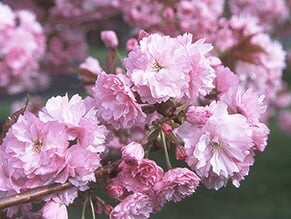
Prunus serrulata
'Kwanzan'
Kwanzan Japanese Flowering
- With deep pink, fully double flowers that hang in bunches alongside emerging, reddish-bronze foliage. An eye-catching springtime sight. 20-25' tall with a vase-shaped outline. Full Sun. Hardy to USDA Zones 5-8.
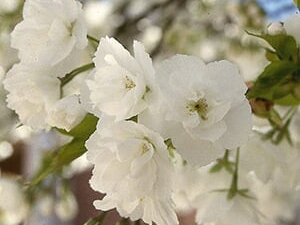
Prunus serrulata
‘Mt. Fuji’
Mt. Fuji Japanese Flowering Cherry
– This white-flowering cherry tree has an upright and horizontal habit. Foliage is a medium green and is golden in fall. Prefers full sun. Matures at 20’ tall x 25’ wide. Hardy in USDA zones 5-7.
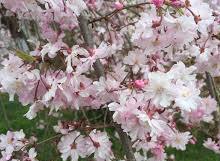
Prunus subhirtella
'Pendula'
Weeping Higan Cherry - Noted for its weeping, cascading habit and the profusion of showy pink flowers that blooms in late winter to early spring, before the leaves foliage. Single or double-flowering, Higan cherry blooms consists of half-inch wide pink flowers that hang in pendulous clusters. Grows well on a wide range of sites. It’s best to avoid those which are poorly drained. Matures at 15 to 20 feet tall with equal spread. Prefers full sun. Hardy to USDA Zones 5-8.
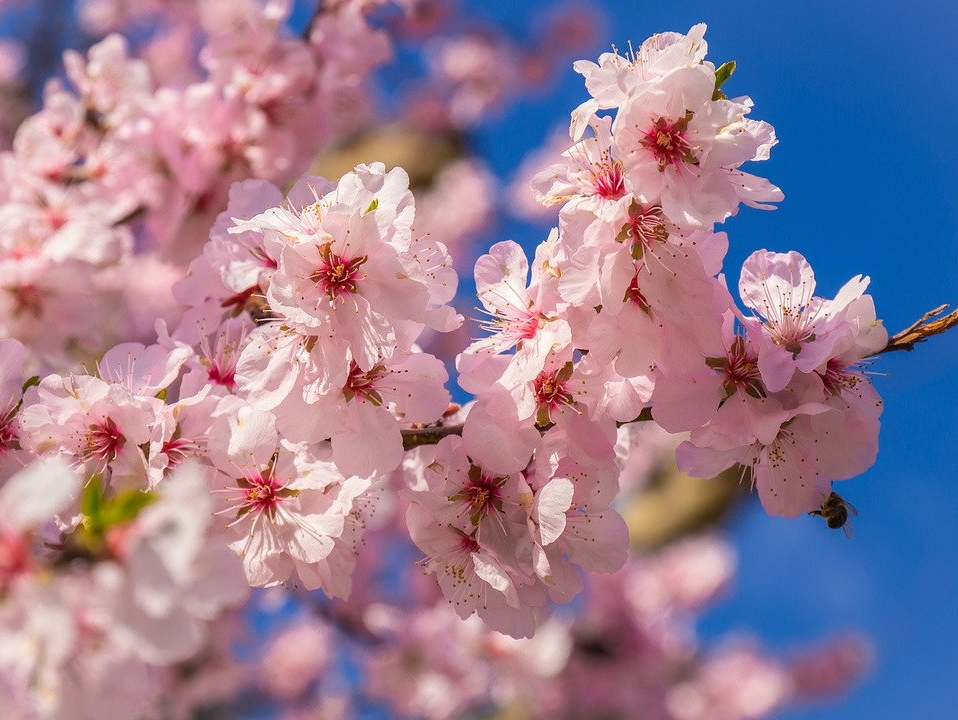
Prunus x yedoensis
‘Akebono’
Akebono Flowering Cherry
– This pink flowering cherry tree has a horizontal habit. The foliage is a medium green that turns golden in fall. Matures at 25’ tall and wide. Prefers full sun. Hardy in USDA zones 4-8.

Pyrus calleryana
'Chanticleer'
Chanticleer Flowering Pear
- A fine upright-pyramidal form. Prolific white flowers in spring. The fall color is reddish-purple. Very adaptable to many different soils; tolerates drying and pollution. Grows 35 feet tall and 16 feet wide in 15 years. Full Sun. Hardy to USDA zone 4.
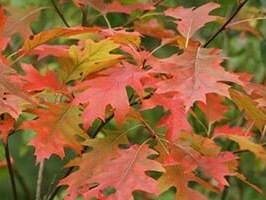
Quercus rubra
Northern Red Oak
– An excellent choice for homeowners who want a quality shade tree as quickly as possible. Superb large tree with its rounded growth habit in youth and maturity. Dark green leaves turn a range of colors occurs from yellow-brown to russet-red to bright red. In the fall, acorns provide an early harvest for animals. This tree does best in sandy loam soils which are well-drained and acidic. It seems to thrive in the urban areas where air pollution can be a problem. Grows about 1 foot per year reaching 60 feet at maturity with equal spread thus forming a rounded and ascending tree. Prefers full sun. Hardy in USDA zones 4-8.
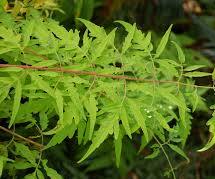
Rhus typhina
‘Bailtiger’
Bailtiger Sumac
- This Tiger’s Eyes Sumac is known for its interesting cut foliage in medium green that turns a beautiful range of colors from golden to deep orange-red. The felted rust-colored bark is one of its striking features. Prefers full sun. Matures at 6’ tall and wide. Hardy in USDA zone 4-8.

Rhus typhina
'Laciniata'
Laceleaf Staghorn Sumac
– Use for naturalizing, on difficult slopes, banks in large areas. New spring growth on stout velvety stems- the "staghorn". Summer foliage is dark green, turning yellow-orange and scarlet in fall with crimson fruit arranged in pyramidal panicles. Prefers well-drained soil but does tolerate dry soils. Can be rejuvenated by cutting to the ground. Grows to 15 feet tall with equal to greater spread. Prefers full sun. Hardy to USDA zone 3.
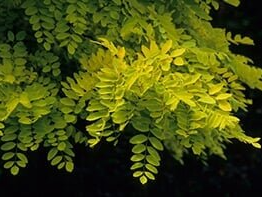
Robinia pseudoacacia
'Frisia'
Golden Black Locust
- Adapts readily to a wide range of soil types, as long as there is good drainage. It grows fast in full sun and fertile, humus-rich soil with regular summer irrigation. Once established, it is extremely drought tolerant. Gardening beneath golden false acacia can cause root suckers; remove them as close to the underground root as possible. This brilliantly colored tree creates a roughly rectangular outline with coarse, dramatic, brittle gray-black branches. Ten-year-old trees reach 20 to 25 feet tall and 12 to 15 feet wide. Mature trees reach 40 to 50 feet tall and 20 to 30 feet wide. Hardy to USDA zone 4.
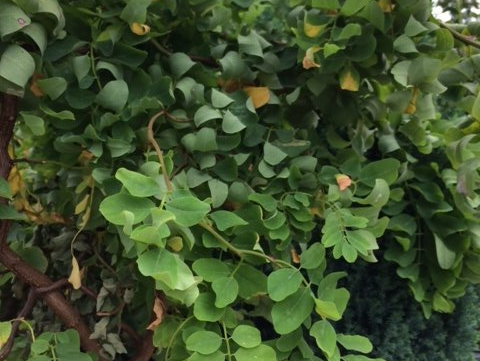
Robinia pseudoacacia
‘Lace Lady’
Lace Lady Black Locust
– This unique tree has twisting contorted foliage and branches for a unique texture. The soft to medium green foliage turns golden in fall. Matures at 15’ tall and wide. Prefers full sun. Hardy in USDA zones 4-9.
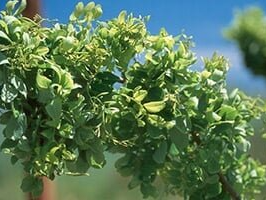
Robinia pseudoacacia
'Twisty Baby'
Twisty Baby Black Locust
- Deciduous multi-stemmed shrub or small tree. A tree worthy of being a focal point in the connoisseur's garden. Tight, bright green leaf clusters hang down like wisteria blooms. In winter twisted zig-zag branches add interest. Grows to 15 feet tall, equal spread, leaves turn yellow in fall. Sun to part shade. Hardy to USDA Zone 4.
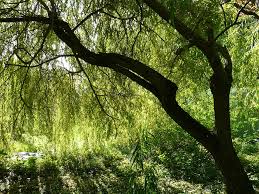
Salix alba
‘Niobe’
Weeping Willow Tree
– This striking iconic tree has weeping pendulant branches and foliage. The medium green leaves turn golden in fall. Matures at 50’ tall and wide. Prefers full sun. Hardy to USDA zone 4.
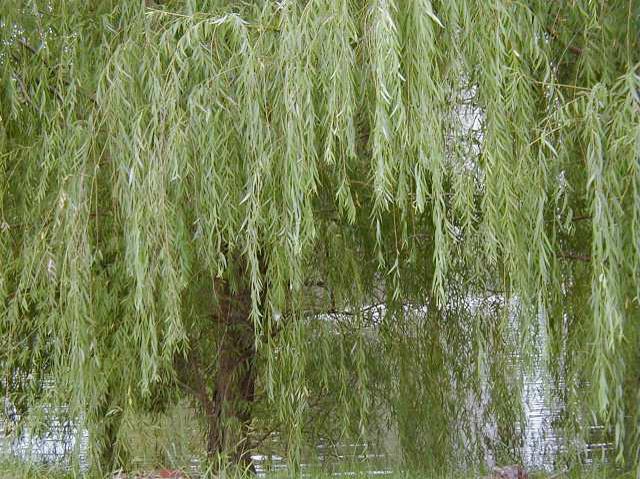
Salix babylonica
Weeping Willow Tree - A bold tree for a large area. The weeping willow has pendulous limbs making it an excellent shade tree. Medium green leaves turn golden in fall. Matures at 50’ tall and wide. Prefers full sun. Hardy to USDA zone 4.
Salix babylonica
‘Crispa’
Crispa Willow Tree
– This weeping willow tree is known not only for its stature and pendulous branches, as well as, its uniquely contorted foliage. Matures at 40-50’ tall and wide. Prefers full sun. Hardy to USDA zone 4.
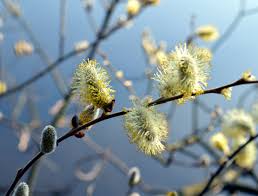
Salix caprea
'Pendula'
Weeping Pussy Willow
- This small, umbrella-shaped tree adds interest as a handsome accent for the small garden. In the spring, March till April, it explodes into yellow-white pussy willow blossoms. It blooms prior to leaves emerging; this blooming can last up to a month. This is an ideal cultivar for that wet spot in the yard. Grows to 6-8 feet tall and 6 feet wide. It can tolerate light shade but prefers full sun. Hardy in USDA zones 4-8.
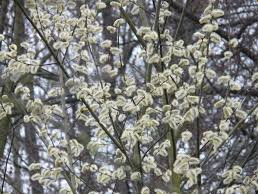
Salix chaemoneloides
Giant Pussy Willow – This fast-growing tree/shrub is known for its large felted buds. Medium green foliage turns golden in fall. Matures at 6-8’ tall x 4-8’ wide. Prefers full to partial sun. Hardy in USDA zones 5-8.
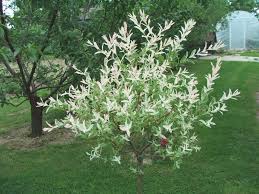
Salix integra
‘Hakuro Nishiki’
Dappled Willow on Standard
- Beautiful pink to white and green variegated foliage is the striking feature of this shrub/tree. Matures at 6-8’ tall and wide. Prefers partial sun. Hardy in USDA zones 5-8.
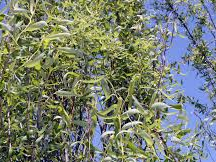
Salix matsudana
‘Golden Curls’
Golden Curls Willow
– This curly willow tree has golden-green foliage on twisting branches. Maturing at 35’ tall and wide. Prefers full sun. Hardy in USDA zones 5-8.

Stewartia pseudocamellia
Japanese Stewartia
– It thrives in humus-rich, well-drained soil. Typically a single-stemmed tree with delicate layered branching habit, Stewartia pseudocamellia grows to about 12 feet high and 6 feet wide in ten years, maturing at 20 to 25 feet high and 12 feet wide. Grows best in partial shade. It will tolerate full sun if kept out of hot spots (for example, against a reflective wall) and watered attentively. Hardy to USDA zone 4.
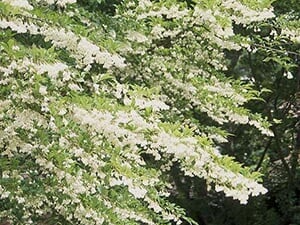
Styrax japonicus
Fragrant Japanese Snowbell
- Deciduous tree, leaves alternate, and are simple, broad-elliptic to elliptic-oblong. Flowers are perfect and bell-shaped, white with yellow stamens, each on a pendulous stalk. Teeming with flowers in May-June. Fruit is dry, oval and light gray developing in summer. Best in acid soil supplemented with organic matter. Grows to 15-25 feet tall, similar width, low and horizontal branching. Prefers sun to part shade. Hardy to USDA zone 5.
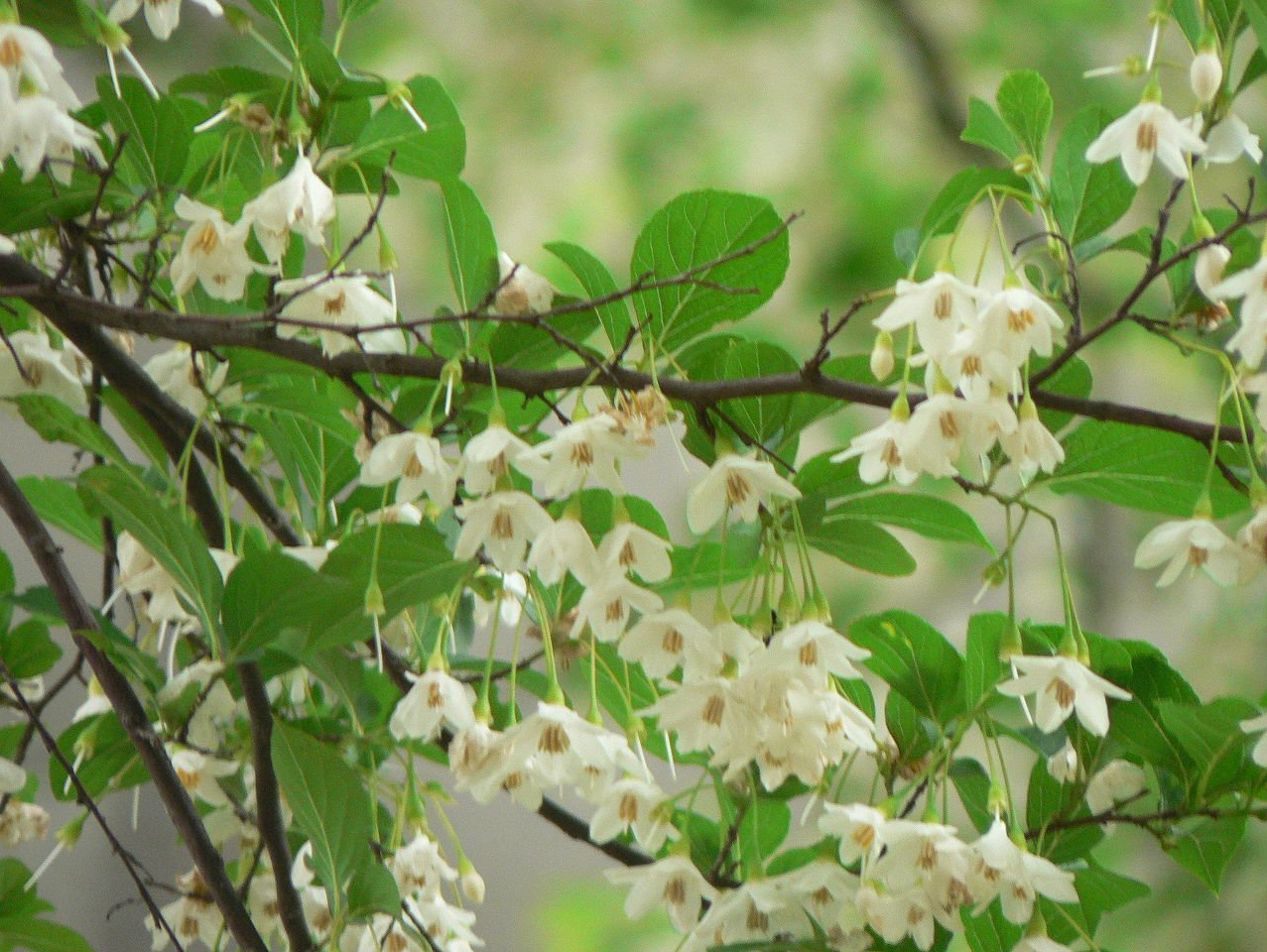
Styrax japonicus
‘Carillon Pendula’
Carillon Pendula Weeping Japanese Snowbell
– This graceful tree bears white bell-shaped fragrant flowers in spring and medium green lance-shaped leaves. The weeping tree is smaller than the straight form of Japanese Snowbell reaching a height of 8-12’ tall and 8-12’ wide. Prefers full sun. Hardy in USDA zones 5-9.
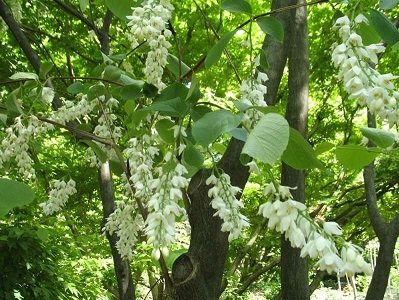
Styrax obassia
Fragrant Japanese Snowbell
- Fragrant, white flowers open in May and June. Large dark green leaves provide a bold texture. Makes a great specimen and is a striking landscape element. Will reach 20-30 feet tall. Prefers sun to part shade. Hardy to USDA zone 5.
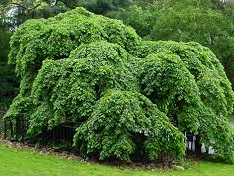
Ulmus glabra
'Camperdownii'
Camperdown Elm
– In the summer its leaves form a canopy that cascades to the ground. Yellow in the fall, revealing an impressive framework of weeping branches. Slow grower to 20 feet tall. Prefers sun or light shade. Hardy to USDA zone 4.
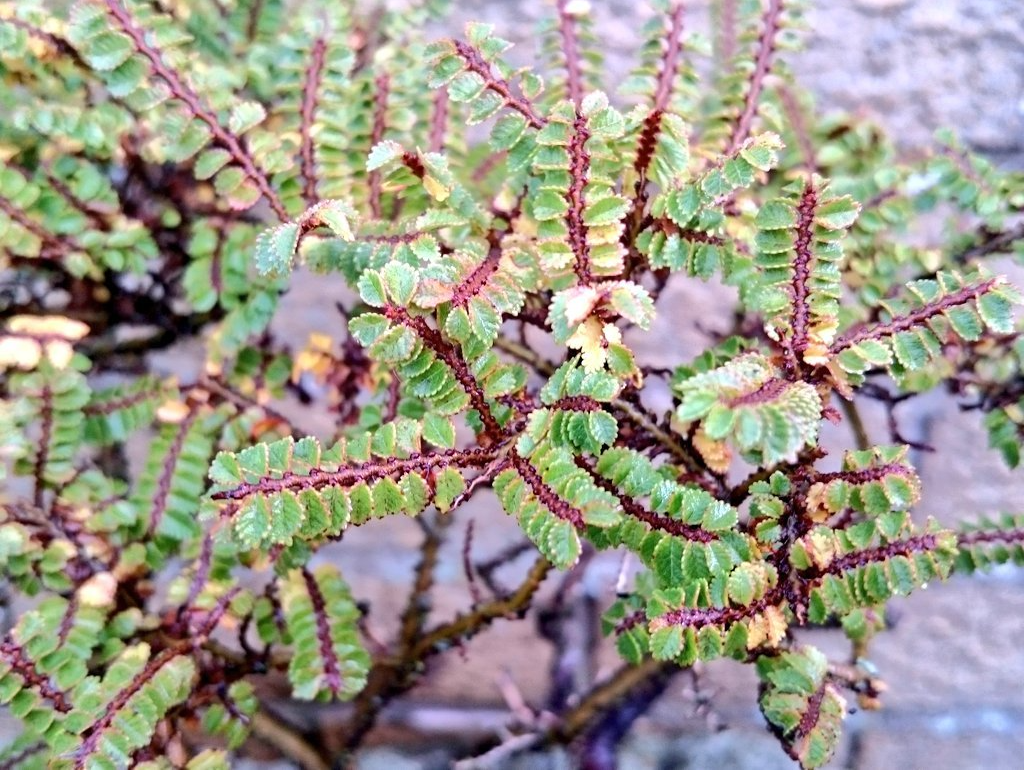
Ulmus parvifolia
‘Hokkaido’
Hokkaido Elm
- Also known as Chinese Elm, it has tiny dark green leaves and cork like bark. Prefers full sun. Matures at 3’ tall x 3’ wide. Hardy in USDA zones 4-9.
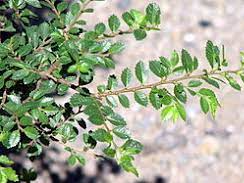
Ulmus parvifolia
‘Seiju’
Seiju Elm
– This dwarf Chinese Elm has medium green foliage. Branches develop cork like exfoliating bark with age. Matures 6’ tall x 4’ wide. Prefers full to partial sun. Hardy in USDA zones 4-9.




